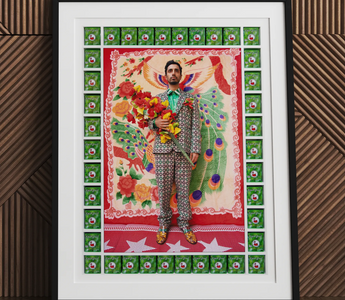Maximalism isn't chaos. It’s memory in drag. A counter-archive of textile, pigment, enamel, bead and neon. Across continents and decades, these artists refused austerity’s false sanctity—sewing quilts with ancestral grief, scripting politics in filigree, sculpting opulence as dissent. This isn’t just about taste and style. It’s about resistance carved in color, pattern, and scale.
Clearly, I adore maximalist art. I built this whole treasure chest around it. And now I’ve handpicked these 20 maximalist artists for you to meet. They stitched feminist critique into wallpaper. Bent ornament into protest. Made sculpture from sweat. Painted grief in gloss. Their works don’t apologize for their volume—they argue through it. They insist pleasure has a history. Decoration has bloodlines. And maximalism? It was never aesthetic indulgence. It has always been a method. A mirror. A memory device grounded in the idea that too much is never enough.
So, if you’re looking for silence, you’re already lost. For those who know more is more is more... let’s get wanderlost!
20 Maximalist Artists To Make Your Heart Sing
1
Hassan Hajjaj
Watch: Hassan Hajjaj: The Rebirth of Cool via Plastik Magazine
 Hassan Hajjaj. Riz Ahmed, 2019/1440 (Gregorian/Hijri). Metallic Lambda on 3mm Dibond in a Poplar Sprayed-White Frame with Green Swan Tea Boxes.
Hassan Hajjaj. Riz Ahmed, 2019/1440 (Gregorian/Hijri). Metallic Lambda on 3mm Dibond in a Poplar Sprayed-White Frame with Green Swan Tea Boxes.
...
Hassan Hajjaj is maximalism with teeth. Not decoration, but aesthetic confrontation disguised in pattern. A Marrakech-born, London-forged provocateur of style and spectacle, Hajjaj folds the global machinery of commercial branding into the hand-stitched syntax of Moroccan street aesthetics. His work does not blend—it crashes. And from that collision, something impossibly seductive emerges: a style so saturated with references it becomes its own dialect.
And not just for Riz Ahmed. Cardi B is also a fan. Of course she is—Hajjaj builds portraits like he’s DJing across continents. Pop stars and street hustlers, high fashion and medina slang, Islamic geometry and corner-shop kitsch—all remix into something louder than origin.
The comparisons to Warhol? They come quick and cheap. But they’re both bait and misdirection. Warhol screen-printed soup cans. Hajjaj frames his subjects in soda crates, candy tins, Harira labels, fake Louis Vuitton. Not as homage. As critique in couture. He dares the viewer to mistake commodification for glamour, knowing full well they will. That’s the joke. And the trap.
Biographical Background
Born in Larache, Morocco, in 1961, Hajjaj moved to London in the 1980s, a city that shaped his lens as sharply as his home country stitched his soul. Between the alleys of Marrakech and the markets of Camden Town, his eye was tuned to contradiction. The Eurocentric museum and the souk. The fashion week runway and the concrete back alley. These dualities don’t get resolved in his work—they get layered, repeated, reframed until they shout wonder and delight.
Hajjaj now works fluidly between cities: London, Marrakech, and a rotating global axis of exhibitions, pop-ups, and collaborations that refuse to respect the borders of genre, geography, or medium.
Artistic Style and Work
Photography, clothing design, furniture, performance—his practice is kaleidoscopic. He builds worlds that overwhelm by design, where Moroccan clichés are inverted, remixed, and exploded into new semiotic economies. His portraits often feature figures mid-pose, dressed in Adidas-patterned djellabas, seated on crates stacked like mosaic tiles, their gaze as cool as chrome, surrounded by brand-stamped frames that weaponize repetition into irony.
The maximalism here isn’t excess for excess’s sake. It’s a trapdoor beneath the spectacle. It lures you with color—then drops you into critique.
He collaborates with musicians, actors, dancers. His subjects are always seen, always stylized, always decolonized. They are not represented—they are reframed, literally and metaphorically. Hajjaj’s work doesn’t just depict Moroccan identity; it dismantles and reassembles it through the kaleidoscope of diaspora, capitalism, and contemporary street vernacular.
Andy Wahloo Collection
Then there’s the fashion line: Andy Wahloo. The name itself is a punchline in three languages—a play on Warhol, but in Maghrebi Arabic, “Wahloo” means “I have nothing.” Which is, of course, a lie. The collection has everything—color riots, checkerboard caftans, polka-dotted trousers, Western silhouettes grafted onto North African tailoring.
But this is not fashion as surface—it’s maximalism as cultural détournement. The garments speak in accents: Parisian swagger, Berber embroidery, Camden kitsch. They’re made to look like knockoffs and feel like heirlooms. You don’t wear Andy Wahloo. You get worn by it.
And in doing so, you participate in Hajjaj’s central project: the satirical camouflage of global capitalism, its glossy veneer peeled back by tea-box borders and clashing textile patterns. Andy Wahloo isn't a clothing label. It’s a semiotic loop with sleeves.
Exhibitions and Recognition
Hajjaj has shown work in major institutions—the Brooklyn Museum, Somerset House, Los Angeles County Museum of Art, and dozens more. But the street never leaves his practice. His pop-ups often resemble market stalls. His installations reek of mint tea and cigarette ash.
He’s been profiled by The New York Times, Dazed, Vogue, and art journals that tried to make him fit a box he already painted over. Recognition, sure. But Hajjaj doesn’t build for the market. He builds like a tagger tags—a message for the people who know where to look.
Impact on Culture
This is where Hajjaj detonates expectations most precisely. His maximalism does not erase tradition. It sharpens it. The bold patterns, candy-color palettes, stacked logos, and street signage—these are the visual dialects of post-colonial remix culture, the kind that refuses to flatten itself for Western consumption.
In an art world still allergic to joy that isn’t whitewashed, Hajjaj’s color is resistance. His repetition is memory. His style is an argument that aesthetics are political terrain.
Through photography, Fashion, and framing, Hajjaj has done what few artists dare: make maximalism not only seen, but necessary.
2
Kehinde Wiley
Watch: Kehinde Wiley: A New Republic via Brooklyn Museum
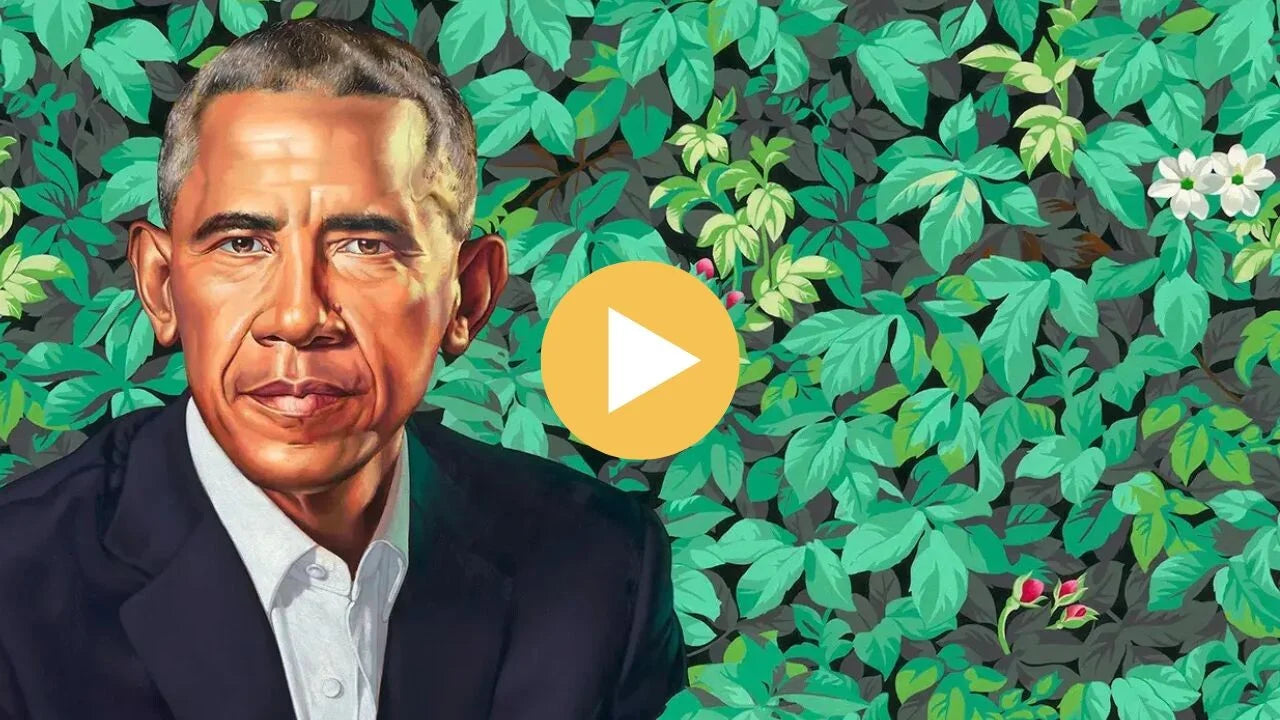 Kehinde Wiley. Barack Obama, 2018. Oil on canvas.
Kehinde Wiley. Barack Obama, 2018. Oil on canvas.
...
Kehinde Wiley does not paint portraits. He stages mythologies, drenched in ornament and saturated with subversion. To call his work maximalist is to name the visible tip of a far deeper refusal—a refusal of absence, of erasure, of the canon that told Black subjects they were too modern to be ancient, too present to be eternal. Wiley enters the halls of European aristocratic portraiture not to blend in, but to remake the walls.
Maximalist Portraits
Wiley’s portraits overwhelm with precision. The textile backdrops bloom like stained glass hallucinations—rococo gardens, damask explosions, folkloric embroidery patterns so intense they devour foreground and background distinction. His sitters—young, Black, regal—float and fuse with these vegetal realms. The effect is disorienting on purpose. A maximalist collapse of subject and history. The body doesn’t just inhabit the image; it absorbs and reshapes the ornamental architecture once reserved for kings, popes, and oil tycoons.
The maximalism here is ideological. Each leaf and tendril marks an inversion of colonial gaze. Wiley’s brushwork doesn’t mimic aristocratic oil painting—it exposes its politics and implants new royalty.
Exhibitions and Influence
Wiley’s maximalist grammar has hung in palaces and protest spaces alike. From his celebrated Kehinde Wiley: A New Republic retrospective at the Brooklyn Museum to his presence in group shows like Less Is a Bore: Maximalist Art, his impact is unmistakable. These aren’t just exhibitions—they’re counter-narratives rendered in enamel.
He has expanded the frame of maximalist portraiture to include ceramic busts, stained glass altarpieces, even bronze equestrian monuments. Each medium becomes a weaponized opulence. Each exhibition a throne room for the historically excluded. Wiley doesn’t just decorate the gallery—he decolonizes it in rococo.
Connection to Modern Trends
The long-tired binary between minimalism and maximalism collapsed the moment Wiley painted a hoodie in gold leaf. His aesthetic speaks directly to the 21st-century rejection of restraint—not as rebellion, but as necessity. Fast Company referenced Wiley among artists redefining maximalism through Black experience—proof that extravagance can be the vocabulary of survival.
His work tracks with 2023’s revival of maximalism in design, media, and fashion—but Wiley's practice isn’t a trend response. It’s a historical confrontation. His backdrops cite everything minimalism edited out: ancestral textiles, queer flourish, spiritual abundance.
Wiley’s maximalism is the opposite of clutter. It is intentional saturation—each pattern a voice in a chorus of reclamation.
Obama’s Portrait
Perhaps his most iconic maximalist provocation is the official portrait of President Barack Obama, unveiled in 2018. Wiley placed Obama seated against a backdrop of floating foliage—chrysanthemums for Chicago, jasmine for Hawaii, and African blue lilies for his father’s Kenyan lineage. No column. No flag. Just botanic symbolism unspooling like a coded inheritance.
The painting did not simply depict a president. It transformed the genre. It reinserted memory into a historically amnesiac format. Every vine curled around Obama's body like a genealogical diagram. Each bloom pulsed with diasporic memory. Wiley’s maximalist composition didn’t just surround Obama—it historicized him.
The response was global. Awe. Controversy. Copycat aesthetics. And still the painting holds its quiet power. A Black man in command, not just of a nation, but of the painted frame that tried for centuries to lock him out.
Wiley’s maximalism, then, is not simply decorative. It is a politics of presence made visible through saturation. He doesn’t just paint people into history—he patterns them into permanence.
3
Joyce Kozloff
Watch: Joyce Kozloff on the art world in the '70s | Under the Cover via Artforum
 Joyce Kozloff. JEEZ, 2012. Acrylic on panels.
Joyce Kozloff. JEEZ, 2012. Acrylic on panels.
...
Joyce Kozloff’s maximalism doesn’t decorate. Each tile, each flourish, each tessellation is a direct affront to the hierarchy that once dismissed “pattern” as feminine, trivial, lesser. Her work swells with ornament, yes, but never with apology. Kozloff’s project is maximalist because it had to be: it had to occupy, to saturate, to overwhelm in order to be seen in a world where minimalism reigned as the unspoken language of power.
Maximalist through and through
Color, excess, ornamentation—these were her weapons. Starting in the 1970s, Kozloff's canvases unraveled the dogmas of high modernism with embroidered ferocity. Her pieces are topographies of visual density, political memory, and aesthetic vengeance.
In 1979, she shifted scale—from intimate pattern works to large-scale public art, embedding her vision in airports, subways, schools, and courthouses. If the museum wouldn’t grant space to her maximalist feminist politics, she would insert it into civic infrastructure. And it worked. Her art redefined the very walls that had kept her out.
Co-founded the Los Angeles Council of Women Artists (1971)
But before that, she co-founded the Los Angeles Council of Women Artists—launching some of the first organized protests against institutional sexism in American art. It wasn’t just about being excluded from LACMA exhibitions and collections. It was about the logic that governed exclusion: the belief that beauty was shallow, decoration disposable, and women's work peripheral. Kozloff’s maximalism torched those assumptions with pattern and pigment.
Exploring Decorative Arts
Her travels—Mexico, Morocco, Turkey—didn’t just inspire motifs. They triggered a realization: the so-called “decorative” arts weren’t decorative at all. They were archives of suppressed voices, encoded in form and surface. What the Western canon deemed feminine or non-Western, Kozloff recognized as a coded language of resistance.
She painted like a cartographer who’d swallowed every rug pattern, dome ceiling, and ceramic schema she ever saw—then exploded them onto canvas with kaleidoscopic intent. Every repetition was an act of refusal. Every border was a frame turned inside out.
Writing "Art Hysterical Notions of Progress and Culture"
In 1978, Kozloff co-authored—with Valerie Jaudon—a revolutionary text that eviscerated the false neutrality of Western art history. In "Art Hysterical Notions of Progress and Culture," they dismantled the binaries of high/low, male/female, West/Other, and elevated the so-called decorative from footnote to foundation.
The essay was a manifesto, a call to arms, a reclamation of the ornamental as political strategy. Together, they declared that adornment was not excess—it was intellectual architecture, stitched into the margins by those denied the center.
Maps, memory, and power
In the early 1990s, Kozloff turned to cartography, but not as geography—as ideology. She began painting maps that revealed war, empire, and erasure through decorative means. Rivers and borders twisted into baroque flourishes; political trauma rendered in Rococo scale.
These weren’t maps for finding your way—they were maps that showed you how the world was taken. Kozloff turned the grid of colonial conquest into a maximalist terrain of critique. The form remained beautiful—but beauty now served truth, not distraction.
From Targets (which used aerial bomb maps as pattern) to her global tile installations, Kozloff’s mapping became a maximalist confrontation with state power—executed in hues so luminous you didn’t notice the indictment until it had already settled in your chest.
A legacy of unapologetic pattern
There is no minimalism in Kozloff’s world. No restraint. No polite white space. There is only vision—dense, swirling, historical. She weaves mosaics like indictments. She paints as though the world’s secrets are buried in grids and curlicues and needs only saturation to be exposed.
Kozloff’s maximalism is a reclamation of what was always ours. And she didn’t ask to be included—she built a movement where abundance became theory, ornament became protest, and pattern became survival.
4
Frank Stella
Watch: Frank Stella: A Retrospective via Modern Art Museum of Fort Worth
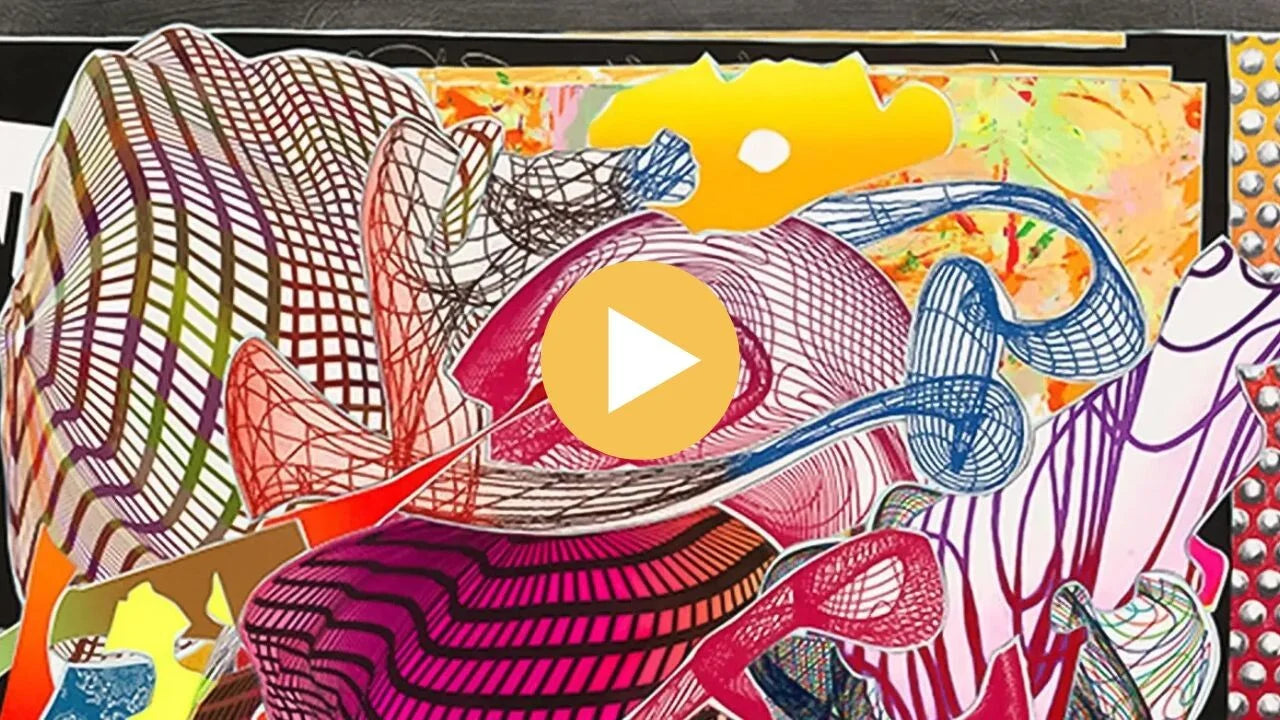 Frank Stella. Feneralia from the Imaginary places series, 1994–97 — via the National Gallery of Australia.
Frank Stella. Feneralia from the Imaginary places series, 1994–97 — via the National Gallery of Australia.
...
Frank Stella didn’t so much evolve from Minimalism to Maximalism as rupture Minimalism from the inside out. His early canvases were declarations of denial: no metaphor, no illusion, no brushwork expressive enough to betray the surface. But beneath that grid of logic was a hunger for spatial upheaval, a quiet scream for release. When it came, it wasn’t incremental. It was operatic.
Recognized for...
Stella first emerged as the hard-edged sovereign of restraint. In the late 1950s and early ’60s, he produced stark, geometric paintings—black stripes, shaped canvases, controlled symmetry—that became icons of the Minimalist movement. These works didn’t “express” emotion; they proclaimed neutrality. “What you see is what you see,” he said, drawing a line in the conceptual sand against the gestural agony of Abstract Expressionism.
But Stella’s Minimalism was never static. Even at its most controlled, it hinted at tension—a need for expansion that would later rupture his flatness and spill into sculptural architecture.
Stella's radical transformation
By the 1970s, Stella had begun his break from the strict codes of earlier work. The transformation wasn’t cosmetic—it was tectonic. What began with concentric patterns and fluorescent hues soon erupted into relief structures, jutting forms, and architectonic explosions of pigment, fiberglass, steel, and aluminum.
His maximalist turn reached full force in the 1980s and ’90s. Canvases ceased to be surfaces and became topographies. Paintings no longer stayed on the wall—they lunged into the viewer’s space with the force of baroque monuments and aerospace prototypes.
This wasn’t just color unleashed. It was geometry unshackled. The work multiplied in dimension and intent, merging sculpture, painting, and industrial design into hybrid beasts that resisted category.
From minimalism to maximalism
Where early Stella emphasized absence, late Stella celebrated saturation—but not in the decorative sense. His maximalism is architectural. Tonal. Spatial. It involves metallic sheen, literary reference, and a chromatic arsenal deployed with precision.
Series like Imaginary Places and Polish Village show how far he traveled. Each piece reads like a collapsed city, a visual operetta, a structure so saturated with gesture and gravity that it forces you to move around it. Minimalist distance became maximalist immersion.
But this evolution wasn’t a betrayal—it was a continuum. The same mind that reduced composition to its atomic geometry now reconstructed it into bombastic, neo-baroque machine-sculptures. The through-line is Stella’s commitment to visual systems, whether tight or ungovernable.
Material choreography
Stella’s materials are themselves maximalist declarations: epoxy, magnesium, etched aluminum, fiberglass, fluorescent alkyds—all orchestrated with symphonic intensity. These aren’t mixed media—they’re weaponized media. Each work becomes an event, an object that bends light and space in ways painting was never supposed to.
His surfaces shimmer with paradox: controlled chaos, engineered emotion, metal rendered painterly. His works don’t depict—they inhabit.
Legacy of a maximalist architect
To call Stella merely a painter is to misname the scale of his ambitions. He’s an architect of form, a composer of surface ruptures, a maximalist not of ornament but of systemic excess.
His late work teaches us that maximalism need not be loud in the traditional sense. It can be rigorous. Mathematical. Operatic without losing its structural backbone. Stella’s maximalism isn’t florid—it’s engineered transcendence.
In an era obsessed with aesthetic dichotomies, Stella carved a new vector: a praxis where abstraction becomes monument, where painting colonizes space, and where volume is both a visual and philosophical act.
5
Robert Kushner
Watch: Robert Kushner via Aurelio Salvador
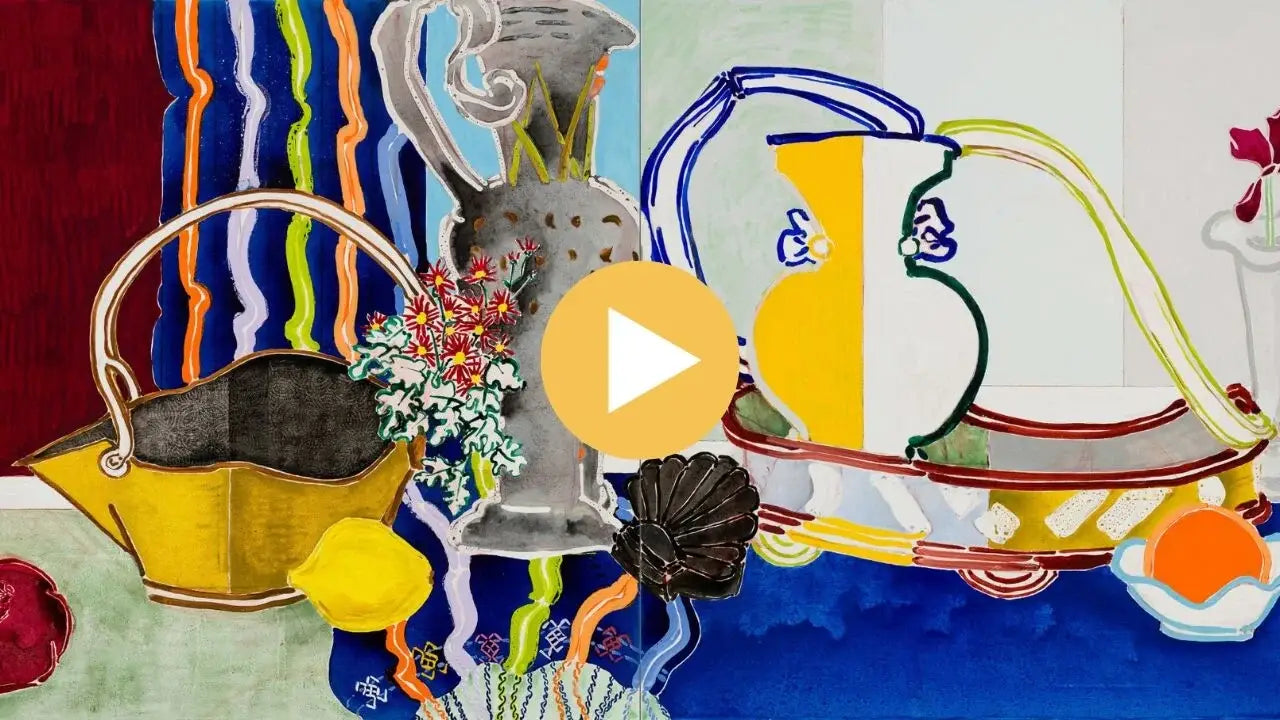 For Betty, Robert Kushner, 2022. Oil, acrylic, and conté crayon on linen.
For Betty, Robert Kushner, 2022. Oil, acrylic, and conté crayon on linen.
...
Robert Kushner's maximalism unfurls in silk and shimmer, in floating peonies and metallic chrysanthemums that dare you to call them decorative. His canvases—opulent, intricate, unapologetically lush—don’t whisper aesthetic pleasure. They declare it as a form of resistance, a patterned archive of traditions that patriarchal modernism tried to suppress.
Pattern and Decoration Movement
Kushner emerged in the 1970s as a founding voice of the Pattern and Decoration movement—an insurgent countercurrent to the sterility of Minimalism and the solemnity of Conceptual Art. Where others stripped away meaning for purity, P&D artists layered meaning through ornament, celebrating the sensual, the historical, the cross-cultural.
Kushner’s allegiance to maximalism came not from excess for its own sake, but from a belief that ornament is a vessel of memory. His paintings integrate Islamic arabesques, Japanese kimono motifs, Byzantine gold, and 19th-century American textiles—not as pastiche, but as historiographic reclamation.
He paints like a couturier raised on ukiyo-e and Persian miniatures, using visual pleasure as a theoretical instrument.
Fabric Artworks
In his early works, fabric wasn’t a surface—it was a statement. Kushner stitched together kimonos, gauze, and robes with paint, beads, and performance. His costumes for live events in the 1970s blurred drag, design, and spiritual theater. Each piece was maximalist not just in color, but in gesture.
By the 1980s, his paintings of florals—anchored by strong verticals and layered media—evolved into textile symphonies. Linen and conté. Gold leaf and acrylic. Hand-dyed silks. The materials themselves spoke across continents. His still lifes echoed Persian tiles; his stems bowed like calligraphy.
To stand in front of a Kushner is to be enveloped—not just visually, but culturally, as if every brushstroke braided a lineage of displaced beauty.
Influences and Exhibitions
Henri Matisse casts a long shadow across Kushner’s oeuvre—not just in his color work, but in the pursuit of joy without guilt. But where Matisse reduced, Kushner accumulates. His influences sprawl: Ottoman embroidery, Qing dynasty porcelain, Art Nouveau wallpaper, ukiyo-e woodblocks.
His work has graced international biennales, solo shows, and museum retrospectives—but it never sheds its outsider’s pulse. Even in the white cube, Kushner’s art feels like a rogue ritual smuggled into a sterile sanctum.
Critics once dismissed his florals as frivolous. They missed the point. Kushner doesn’t seek approval. He seeks restoration—of delight, of historical continuity, of the dignity in pattern.
Collaboration with Other Artists and Movements
Kushner never worked in isolation. His name threads through the Pattern and Decoration movement alongside fellow maximalist visionaries like Joyce Kozloff and Kim MacConnel. Together, they built an aesthetic vocabulary that defied Western hierarchies.
Kushner’s maximalism is symphonic: each painting a chorus of motifs, influences, and materials singing across centuries. He has collaborated with poets, costume designers, and other visual artists—expanding his practice into a kind of interdisciplinary bloom.
This isn’t fusion for trend’s sake. It’s an ethics of entanglement—a commitment to the entangled nature of cultural histories, one brushstroke at a time.
His recent works continue this legacy with renewed intricacy. There is always more to see, more to trace, more to remember. The paintings feel alive because they are layered with cultural DNA—each petal a node in a long-ignored archive.
6
Kim MacConnel
Watch: Kim MacConnel via MOCA Los Angeles
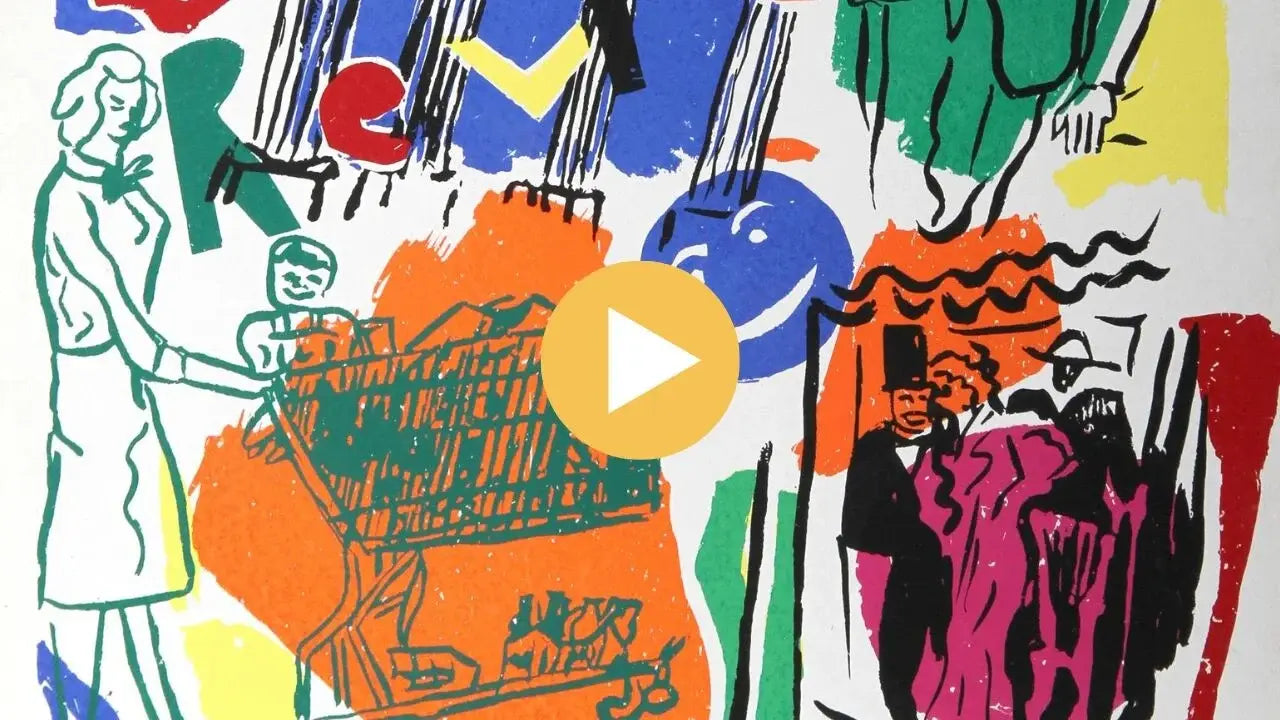 Kim MacConnel. Paris Review, 1982.Silk screen on deckle edge paper.
Kim MacConnel. Paris Review, 1982.Silk screen on deckle edge paper.
...
Nothing about Kim MacConnel behaves. His maximalism isn’t polished or poised—it’s unruly, off-register, like a radio caught between cultures, or a textile mid-dream. MacConnel’s work doesn’t ask you to look—it dares you not to flinch. A collision of motifs, a riot of gesture, a sensory field where every color shouts over the next, his art unfolds like a visual conversation conducted at full volume in multiple dialects.
Pattern and Decoration Movement
One of the original mischief-makers behind the Pattern and Decoration movement, MacConnel helped crack open the white, minimalist silence of the American 1970s art world. While others championed subtraction, he went the opposite direction: layering patterns, textiles, and ornamental codes into maximalist delirium. His work pulses with asymmetry, cultural juxtaposition, and deliberate overload.
Exhibiting at the Holly Solomon Gallery in New York from 1976, MacConnel joined a collective insurgency. These weren’t just pretty surfaces—they were protests against a canon that equated seriousness with suppression. For MacConnel, pattern was a language, and he spoke it with the syntax of disruption.
His canvases don’t settle. They twitch, flicker, and mutate—motifs from Islamic tiles, Navajo blankets, French upholstery, all remixed with a graphic sensibility somewhere between Matisse and Memphis.
Influence on Interior Design
MacConnel didn’t limit his maximalism to wall-bound canvases. He took it into domestic space—living rooms, bedrooms, entire interiors transformed into immersive artworks. Not installations, not décor, but spatial ruptures: rooms that felt like walking into the inside of a concept.
The MacConnel–Lowe House, featured in MXM Maximalist Interiors and published by Harper Design, remains a touchstone of this approach. It’s less a residence and more a theoretical shelter, where bedsheets, door frames, and lampshades collaborate in high-volume harmony.
His rooms weren’t just for living—they were for challenging the very idea of livability. How much color can a wall hold before it screams? How far can ornament go before it becomes language again?
Legacy
MacConnel’s maximalism is not decorative excess—it’s visual improvisation. Like jazz, his forms riff, distort, and return. The work speaks in motifs and echoes, loops and inversions, always on the verge of sense and always on the side of more.
He never chased elegance. He chased energy. His brushstrokes—loose, audacious—insist on movement. His objects—tables, textiles, totems—carry the vernacular weight of global design, mashed together without hierarchy.
Yet within this chaos is a kind of ethical clarity: to disrupt the purity myth, to restore the dignity of the garish, to champion the joy of color as cultural bridgework. His art does not homogenize—it layers, letting contradictions rub against each other until they spark.
MacConnel didn’t just expand what maximalism could be—he repatterned the frame itself. His art reminds us that disorder is not the absence of logic, but the presence of too many simultaneous truths.
7
Miriam Schapiro
Watch: Meet Miriam Shapiro via Smithsonian American Art Museum
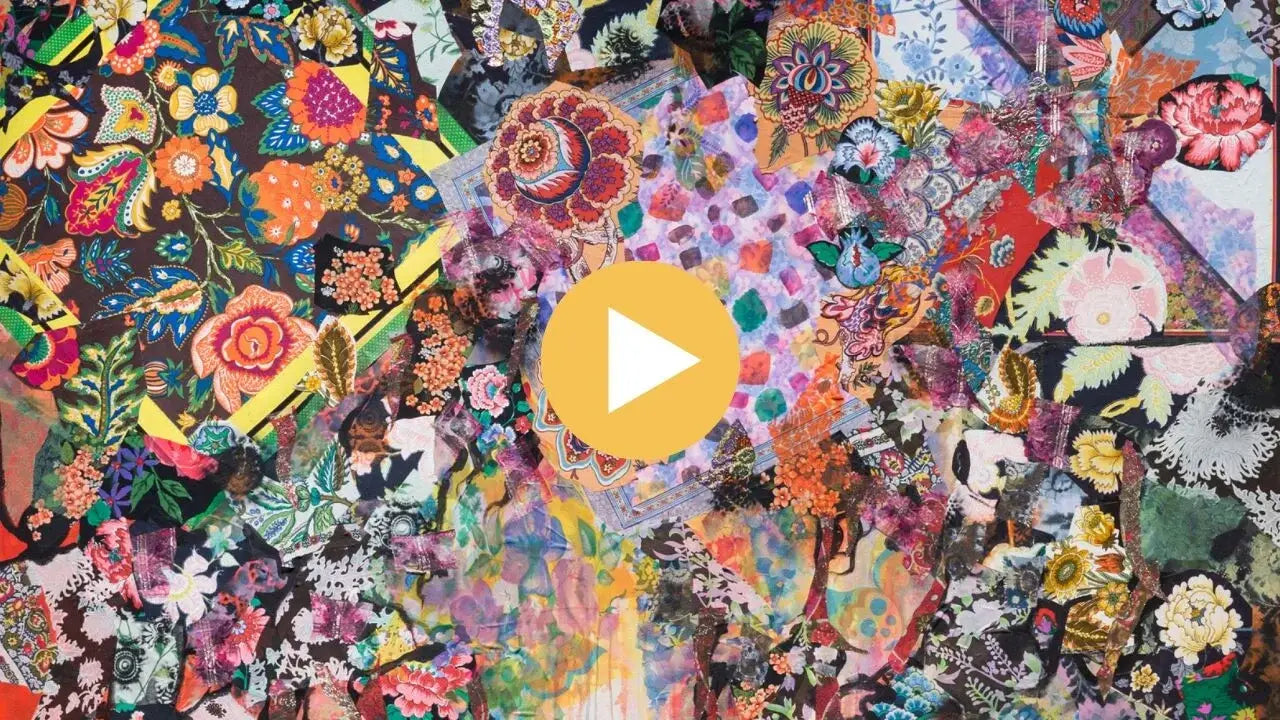 Miriam Shapiro. Beauty of Summer, 1973-74.Acrylicand fabric on canvas.
Miriam Shapiro. Beauty of Summer, 1973-74.Acrylicand fabric on canvas.
...
Maximalism, in the hands of Miriam Schapiro, became a mother tongue. It spoke in stitches, sequins, and stubbornness. She wielded fabric like theory, turned collage into code, and asked why beauty—when saturated, domestic, and feminine—was ever considered weak. For Schapiro, excess wasn’t indulgence. It was resistance sewn with gold thread.
Maximalism in Art
Schapiro didn’t flirt with the Pattern and Decoration movement—she helped will it into being. Her canvases didn’t merely accept embellishment, they were built from it, constructed like quilts where each patch told a story shunted aside by white-cube modernism.
While other maximalists crowded space to defy minimalism, Schapiro filled hers with meaning—the kind inherited matrilineally, whispered across generations, coded in buttons, lace, florals, doilies. Hers was maximalism as maternal archive, as material historiography.
In Beauty of Summer, the acrylic doesn’t dominate—it hosts. It lifts the fabric. It frames the soft as strong. This was her maximalist aesthetic: not a celebration of form alone, but an intervention into who gets to own form at all.
Schapiro didn’t decorate. She reclaimed the decorative—a term long dismissed by critics trained to praise brute steel over embroidery, bare canvas over textured memory.
Feminist Impact
At a time when the gallery system rewarded masculine gesture, Schapiro returned to “craft” with intent. Her maximalism wasn’t about scale—it was about revaluation. Quilting, appliqué, and layering became subversive acts. She created what she called femmage—a fusion of feminist message and collage, of domestic textile art and painterly force.
In an art world allergic to femininity unless mediated by irony, Schapiro took the trappings of womanhood and made them scream. Her works weren’t passive or pretty; they were aggressive, coded, rich with generational defiance. Each fabric square became a palimpsest of labor—both the undervalued work of sewing and the cultural work of remembering.
The 2018 exhibition Surface/Depth: The Decorative After Miriam Schapiro at the Museum of Arts and Design marked the continuation of her disruption. She wasn’t being rediscovered—she was being understood.
Pattern and Decoration Movement
As a central figure in the Pattern and Decoration movement, Schapiro constructed visual fields where repetition became ritual, and ornamentation became language. Her maximalism was not a style—it was an ethic. In opposition to the austerity of post-minimalism, she filled her canvases with layered symbolic systems.
Every motif—fans, hearts, silhouettes—had lineage. The work referenced not just cultural aesthetics, but coded histories of erasure, especially of women artists. Alongside other maximalists in Less Is a Bore: Maximalist Art & Design at the Institute of Contemporary Art, Boston, Schapiro’s pieces refused reduction. They declared abundance as birthright.
Educational Influence
Schapiro didn’t simply make maximalist art. She taught its philosophy, embodied it in pedagogy. As a founder of the Feminist Art Program alongside Judy Chicago, she turned classrooms into collectives and critiques into conversations. At CalArts and beyond, she helped shape a generation that understood that visual saturation could be ideological, not just aesthetic.
Her projects with students—like the iconic Womanhouse—transformed entire buildings into artworks, filled with installations confronting the architecture of gendered labor. These weren’t shows. They were sites of maximalist transformation.
Legacy
Miriam Schapiro’s legacy is interwoven with the fabrics she used—dense, overlapping, soft but unyielding. Her art is cited across disciplines: feminist theory, textile studies, postmodern critique. But what it does best is linger—like perfume in a room, like fingerprints in velvet.
Her invention of femmage remains a critical term, not just for what it defines, but for what it opened up: a space where beauty and rigor are not mutually exclusive, where maximalism is a political act, and where decoration is not the frame, but the force.
Her canvases were never quiet. They laughed, glared, and glittered. And they dared you to say that softness wasn’t a weapon.
8
Takako Yamaguchi
Watch: Takako Yamaguchi via MOCA Los Angeles
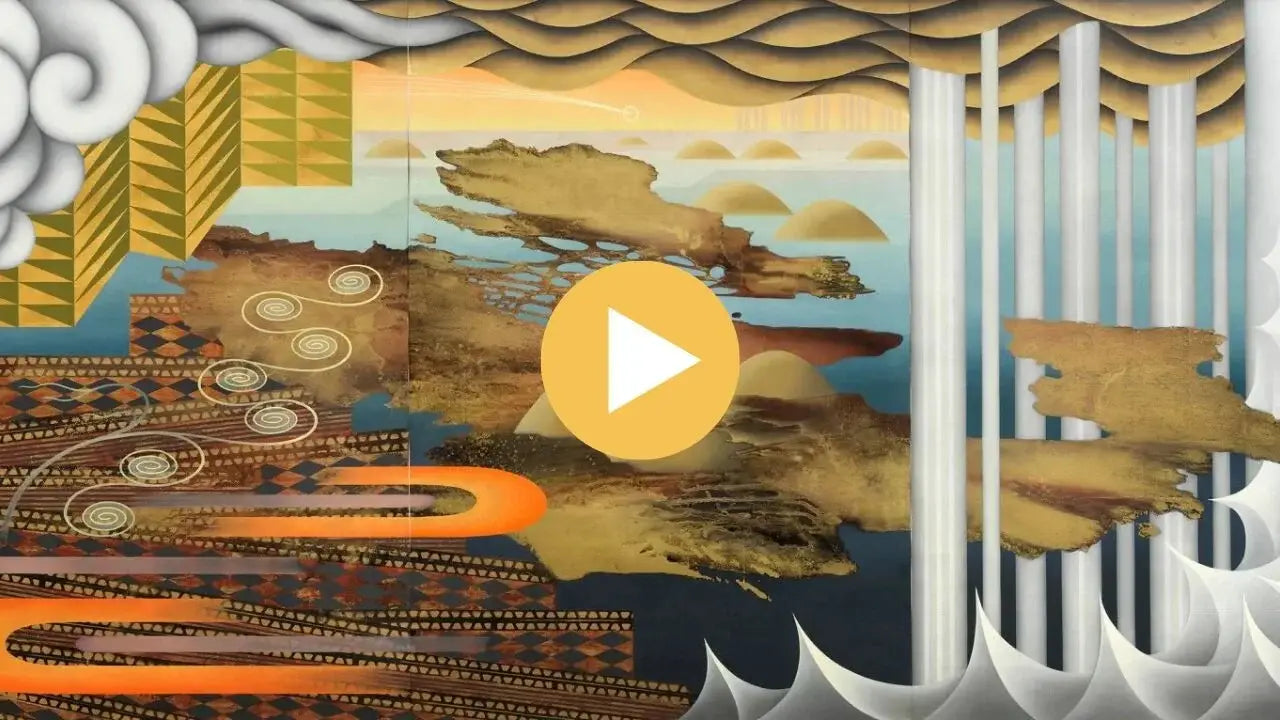 Takako Yamaguchi. Found, Lost and Then Found Again, 2004.
Takako Yamaguchi. Found, Lost and Then Found Again, 2004.
...
What if a seascape could remember everything it ever touched? In the hands of Takako Yamaguchi, the ocean doesn’t just roll—it dreams, archives, and disassembles itself into lacquered myths and polychromatic symmetries. Her paintings don’t depict nature. They stage it, like an opera—where every wave is choreographed, every bloom rehearsed across centuries of aesthetic transmission.
Artistic Style
Yamaguchi’s maximalism lives not in noise but in nuance. Her canvases float in stillness, yet they bristle with intention. Described as “self-contained seaside dreamscapes, they fracture the expectations of what Japanese-American painting should look like.
Her compositions fuse oil paint, glitter, bronze leaf, and mythological suggestion, charting an iconography of contradiction: traditional but not reverent, decorative but never passive, organic but synthetically detailed.
These are not landscapes—they’re fictions of place, built from memory, longing, and the strange distances that open between cultures. Mountains ripple like kimono silk. Clouds arch like brocade. The flora she paints seem culled from scrolls and science fiction at once.
Pattern and Decoration Movement
Although her name may not dominate textbooks, Yamaguchi's contribution to the Pattern and Decoration movement is tectonic. Her involvement—especially through pieces like Magnificat #6, glimmering with oil, bronze leaf, and glitter—repositioned the movement’s American nucleus toward a trans-Pacific vibration.
While Pattern and Decoration in the U.S. often riffed on non-Western motifs from a voyeuristic distance, Yamaguchi reversed the gaze. She reclaimed those motifs from within, speaking not as an observer of ornamentation, but as its internal translator.
In this way, her maximalism becomes a strategy of cultural reassembly. Her use of decorative language is not homage but infiltration, forcing aesthetic categories to acknowledge the blurred borders of cultural production.
Her presence in With Pleasure: Pattern and Decoration in American Art 1972–1985, exhibited at the Hessel Museum of Art, underscored this inversion. Yamaguchi’s work disrupted the Western centrism of the movement, stitching its aspirations to deeper histories of diaspora and hybridity.
Recent Exhibitions
Yamaguchi’s 2023 solo show at Ortuzar Projects, Takako Yamaguchi: New Paintings, reintroduced her practice to an art world still catching up. Here, her canvases swelled with a refined abundance: the maximalism not louder, but tighter, like a baroque fugue transcribed onto surf.
The exhibition’s restraint only sharpened its effect. Her newest works no longer sought to overwhelm. Instead, they radiated slow accumulation—richness without spectacle, excess by way of control.
Her paintings, always enigmatic, have become even more unplaceable. Are they retro-futurist? Buddhist pop? Deco surf realism? Each guess collapses under the layered precision of her forms. She paints the kind of world that doesn’t need to be understood to be felt.
With Pleasure: Pattern and Decoration in American Art 1972–1985
Yamaguchi’s inclusion in With Pleasure marked more than visibility—it was a reframing. Within this maximalist cohort of painters, sculptors, ceramicists, and installation artists, her work offered something quieter but no less saturated.
Her maximalism, unlike that of her American contemporaries, arrived without the need for confrontation. It seduced instead of shocked. Yet beneath its lush surface was a layered critique of minimalism, essentialism, and orientalist reduction.
She made clear that excess isn’t always noisy. Sometimes, it’s sinuous.
9
Raqib Shaw
Watch: Raqib Shaw — Taking Craft to a Crazy, Romantic Extreme via Tate
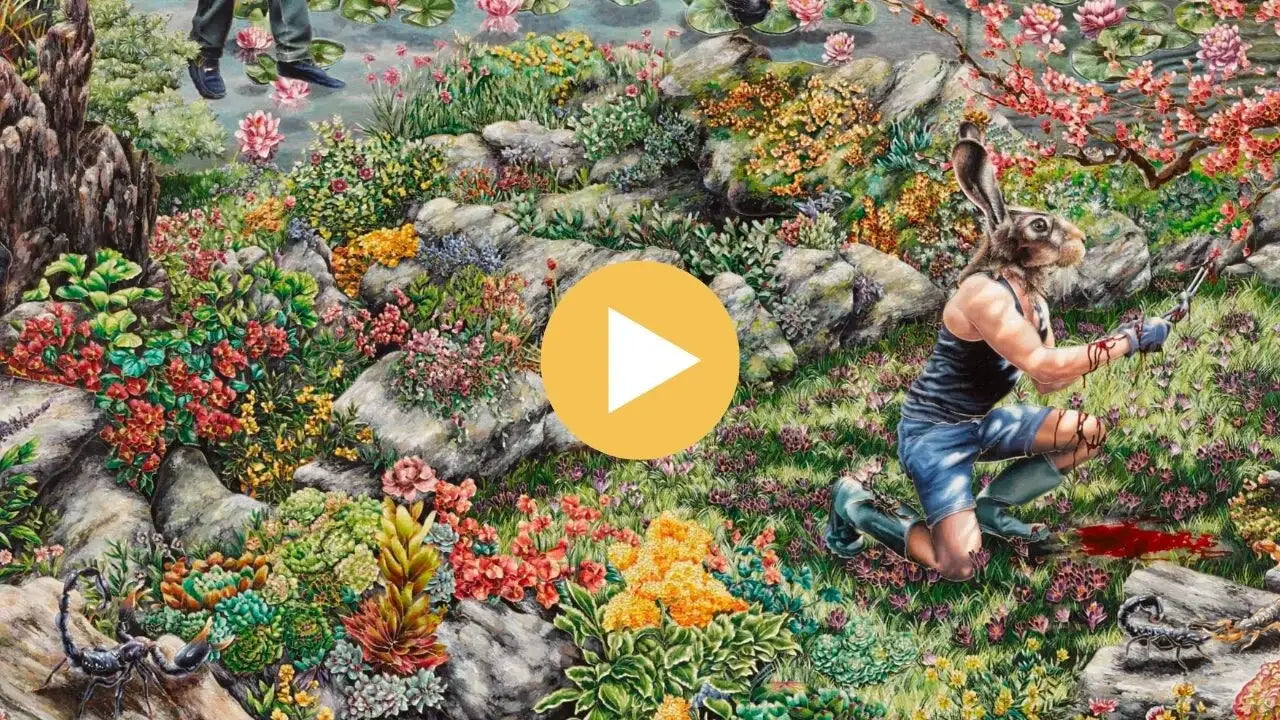 Raqib Shaw. Agony In The Garden (After Tintoretto) II,2020-2021. Acrylic liner and enamel on aluminium.
Raqib Shaw. Agony In The Garden (After Tintoretto) II,2020-2021. Acrylic liner and enamel on aluminium.
...
Raqib Shaw doesn’t paint. He orchestrates obsessions. His canvases swell like mythic palaces hallucinated in a fever dream—palatial interiors infested with peacocks, demons, bleeding orchids, and bodies caught mid-rapture or ruin. Shaw’s maximalism is not decoration—it’s exorcism in enamel.
Born in Kolkata in 1974, raised amid Kashmir’s antique bazaars and jeweled iconography, Shaw absorbed visual language before verbal one. His childhood was a living archive of Persian miniatures, Mughal porcelain, and baroque Catholic kitsch, all vibrating against the Himalayas. That collision—of refinement and brutality, inheritance and exile—infuses every inch of his work.
Artistic practice
His art builds slowly, manically, one millimeter at a time. Acrylic liner, jewels, metallic enamel, and porcupine quills are deployed not for flair but for architecture. Every surface is an altar. Every brushstroke a reckoning. Shaw’s works refuse negative space—his maximalism obliterates stillness, forces your eye to wander until it forgets how to rest.
In Agony in the Garden (After Tintoretto) II, Shaw recasts a Renaissance scene in delirious, decadent violence. Serpents unfurl beneath anguished figures, flowering vines strangle marble columns, and sky becomes blood-glass mosaic. There’s no reverence—only rupture. The holy is refashioned into spectacle.
Shaw doesn’t reference art history—he devours it, then reanimates it inside the viscera of his own queer mythology. The Old Masters are not sacred here; they’re collaborators in a shared theater of maximalist ruin.
Not just paintings
Shaw’s maximalism spills beyond the frame. His practice includes sculpture, ceramics, and immersive installation—each medium a dialect in the same obsessive tongue. His enamel and jewel-encrusted sculptures hum with a grotesque eroticism, like relics looted from a fallen alien empire.
His solo shows—from the White Cube to the Frist Art Museum—are not exhibitions. They’re cosmologies, unfolding across surface and scale. Viewers don’t look; they enter, and risk getting swallowed.
He’s not interested in taste. He’s interested in compulsion. Ornament, for Shaw, is a form of psychic density. His visual abundance isn’t indulgence—it’s entrapment, both a lure and a cage.
Far beyond the art world
While critics grapple with how to categorize him—queer baroque, postcolonial fantasia, dystopian Rococo—Shaw continues building his world unbothered. His use of jewels isn’t glamor. It’s grief crystallized. His gardens aren’t Eden—they’re aftermaths.
Raised in Kashmir, exiled in London, his work aches with displacement. Shaw’s lushness is always tinged with mourning. His landscapes pulse with beauty on the verge of collapse. You feel it in the musculature of his demons. You see it in the peacocks mid-scream.
In every glittering detail, there is a scream stitched into silence.
His canvases are heartbreaks disguised as tapestries. His maximalism is warfare fought with enamel and mythology, where the line between horror and opulence no longer exists.
10
Lari Pittman
Watch: Lari Pittman: Audience | Art21 "Extended Play" via Art21
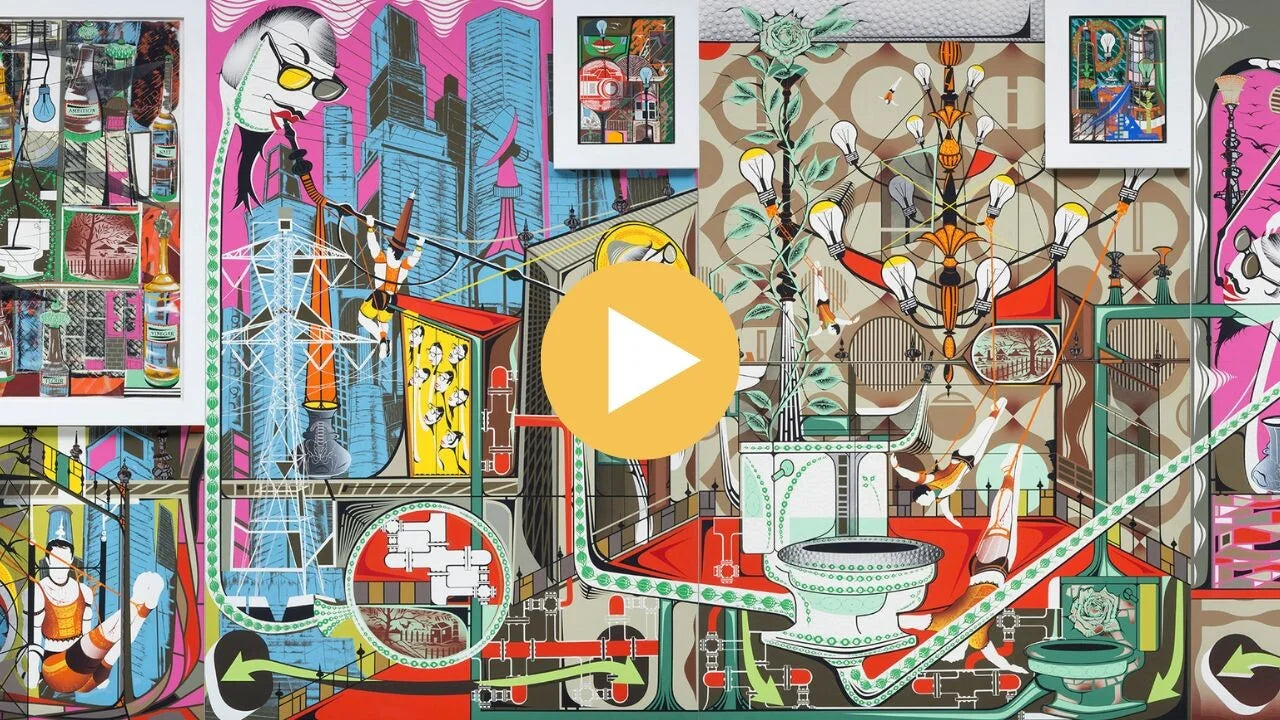
Lari Pittman. Once A Noun, Now A Verb #1, 1997. Oil on mahogany panels.
...
Lari Pittman does not make paintings. He writes fugues in pigment and lacquer. Each canvas a cacophony; each symbol a cipher. If you try to reduce his work to a thesis, it collapses. If you let it surround you, it sings. Pittman’s maximalism isn’t style—it’s insistence. A refusal to simplify the world into digestible form.
Lari Pittman is renowned for the distinctive maximalist style that defines his oeuvre. His paintings speak in tongues. Biblical illustration, interior design, anatomical diagrams, folk signage, calligraphy, floral sprawl—they all collide in the layers. Each layer is legible until it isn’t, and then you start over.
His surfaces throb with contradiction. Baroque flourishes sit beside cartoon speech bubbles. Heraldic crests melt into genital silhouettes. Domestic wallpaper swirls around scenes of war. Pittman’s maximalism is less about ornament and more about overwriting—refusing to let one narrative dominate.
Themes and Subjects
In Pittman’s world, nothing is linear. Narratives branch, loop, collapse. His compositions reflect the fractured logic of memory and trauma. As a queer Chicano artist, his canvases teem with coded desire and cultural dissonance. He paints in metaphor stacked atop metaphor: a style of saturation as resistance.
These paintings aren't just decorative—they're dialectic. They pose questions in images: What is gender when refracted through design history? What is nationhood when floral? What happens when abstraction is made to confess?
His work moves through heterogeneous aspects of contemporary life and culture, with a visual vocabulary that veers from Victorian flourish to futuristic iconography. The paintings become maps of contradiction, guiding viewers through systems of beauty, control, colonization, and survival.
Exhibitions and Recognitions
Pittman’s maximalist career reached new visibility in the retrospective Lari Pittman: Declaration of Independence at the Hammer Museum. But “retrospective” is almost a misnomer—his work doesn’t lend itself to chronology.
Each series is a conversation with all the others. Patterns from early works return in mutated form. Colors echo across decades. Nothing is isolated. His entire oeuvre behaves like a single sprawling novel written across lacquered surfaces.
Exhibited in major international venues, Pittman’s work continues to be a gravitational force for scholars, curators, and viewers seeking an aesthetic that can hold complexity without collapse.
Impact on Contemporary Art
Where minimalism offered the blankness of absolution, Pittman’s maximalism insists on presence—everywhere, all at once. He proved that ornament could carry the same weight as geometry, that decoration could cut like theory.
In the long dialogue between minimalism and maximalism, Pittman’s role is neither mediator nor rival. He’s something else: a maximalist fabulist, constructing parables in paint that queer the notion of taste itself.
His paintings offer no exit, no “clean” modernist resolution. But they do offer revelation—through repetition, contradiction, and excess. Every mark is deliberate. Every flourish, a decision. Every canvas, a cosmos.
11
Valerie Jaudon
Watch: VON LINTEL - Valerie Jaudon via O'Delle Abney
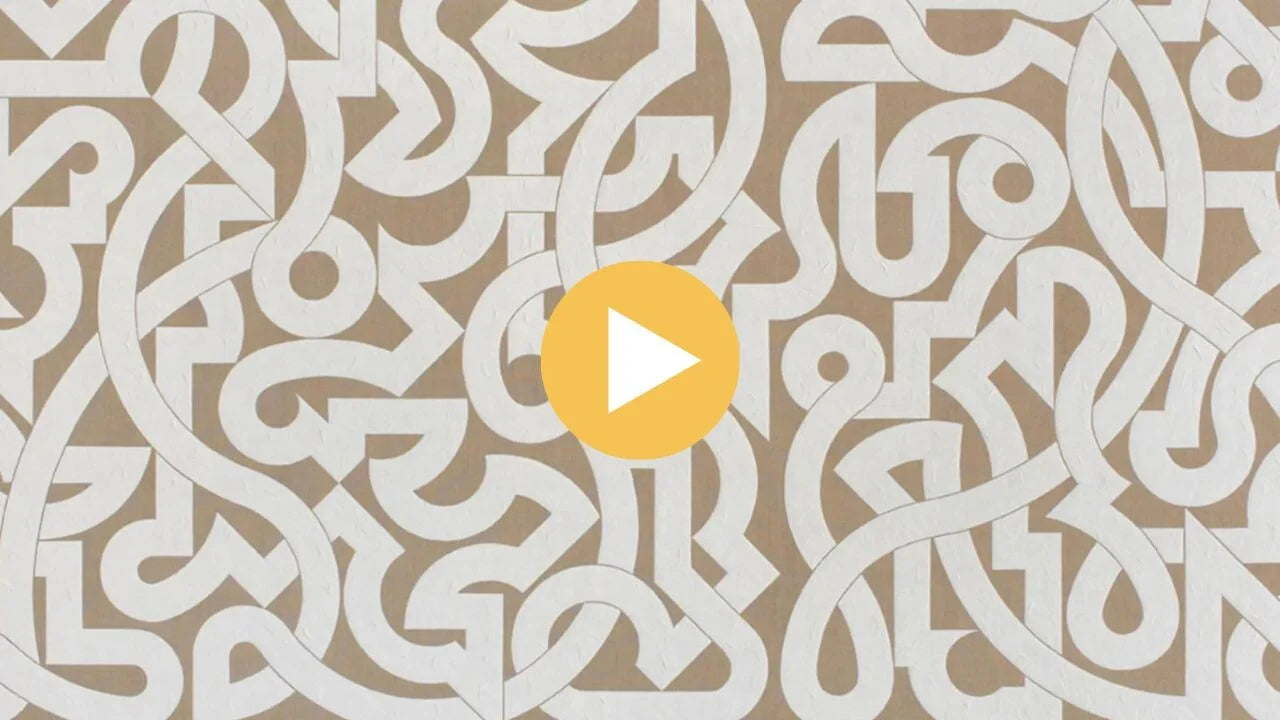 Valerie Jaudon. Barcarolle, 2014. Oil on linen.
Valerie Jaudon. Barcarolle, 2014. Oil on linen.
...
Some maximalists throw color like confetti. Valerie Jaudon prefers knives—geometric, repeating, precise. Her canvases hum with constraint, with rigor, with the kind of beauty that comes not from spontaneity but from discipline pushed to the edge of delirium. Jaudon’s maximalism isn’t ornamental whimsy—it’s architectural warfare.
Each painting is a code: a labyrinth of interlocking motifs, symmetrical ruptures, and pattern loops. You don’t view her work; you decipher it. And once deciphered, it doesn’t soothe—it seethes.
Jaudon is a prominent artist and academic associated with the Pattern and Decoration movement, but she’s also one of its most radical revisionists. Where others pulled inspiration from folk art or floral motifs, Jaudon reached into Gothic tracery, Islamic tiles, early American quilts, and Chinese calligraphy—global systems of order and repetition—and rearranged them until they snapped.
Her designs look ancient and futuristic at once. They pull from sacred geometries, but reject transcendence. Nothing floats. Everything locks into itself, like ideology made image.
Jaudon's Connection to Maximalism
Her maximalism isn’t messy. It’s not about excess of image, but excess of intention. She builds visual logic until it breaks its own spine.
What’s remarkable isn’t just the density of her patterns—it’s the labor. Every curve, knot, and counterform is rendered with monastic meticulousness, but also a sly sense of rebellion. These are not passive patterns. They confront. They accuse. They refuse to behave.
Her detailed and ornate designs are where feminism meets formalism—where surface seduces, then glitterbombs its own elegance.
A notable example is her collaboration with Joyce Kozloff, with whom she co-authored the pivotal 1978 essay Art Hysterical Notions of Progress and Culture, which torched the language that upheld Western, white, male dominance in art criticism. That essay wasn’t a footnote—it was a fuse.
Jaudon’s work does the same thing: it looks like harmony until you read it, then it unravels everything you thought you knew about hierarchy, gender, ornament, and power.
The concept of maximalism in art
Jaudon’s form of maximalism is inseparable from the Pattern and Decoration movement, but her contribution leans heavier on the “pattern” as a method of insurgency. In her hands, repetition becomes a kind of chant. Not meditative—but political. Not healing—but haunting.
By elevating design and surface to primary meaning, she defied centuries of Western dismissal of “decorative art” as lesser, feminine, or utilitarian. Jaudon’s paintings insist that complexity is not a detour from meaning—it is the meaning.
Her work was a centerpiece in Less is a Bore: Maximalist Art & Design at the Institute of Contemporary Art, Boston—a show that finally recognized how vital her visual language has been to the architecture of American maximalism.
Professor at Hunter College
For years, Jaudon has brought this restless precision into academia. At Hunter College, she taught not just painting, but the politics of painting: how materials lie, how style can be a system of control, and how to break it from the inside out. Her pedagogy was an extension of her studio—a place where the so-called decorative became dangerous.
Her contribution to maximalist art is both visual and philosophical. She forged a path where the intellect and the ornamental aren’t opposites—they’re co-conspirators. She didn't just decorate surfaces. She interrogated them.
Jaudon’s legacy is measured not in brushstrokes, but in ruptures—each canvas a gorgeous system that collapses under the weight of its own ideas, and teaches you something as it falls.
12
Merion Estes
Watch: Merion Estes via Joseph Santarromana
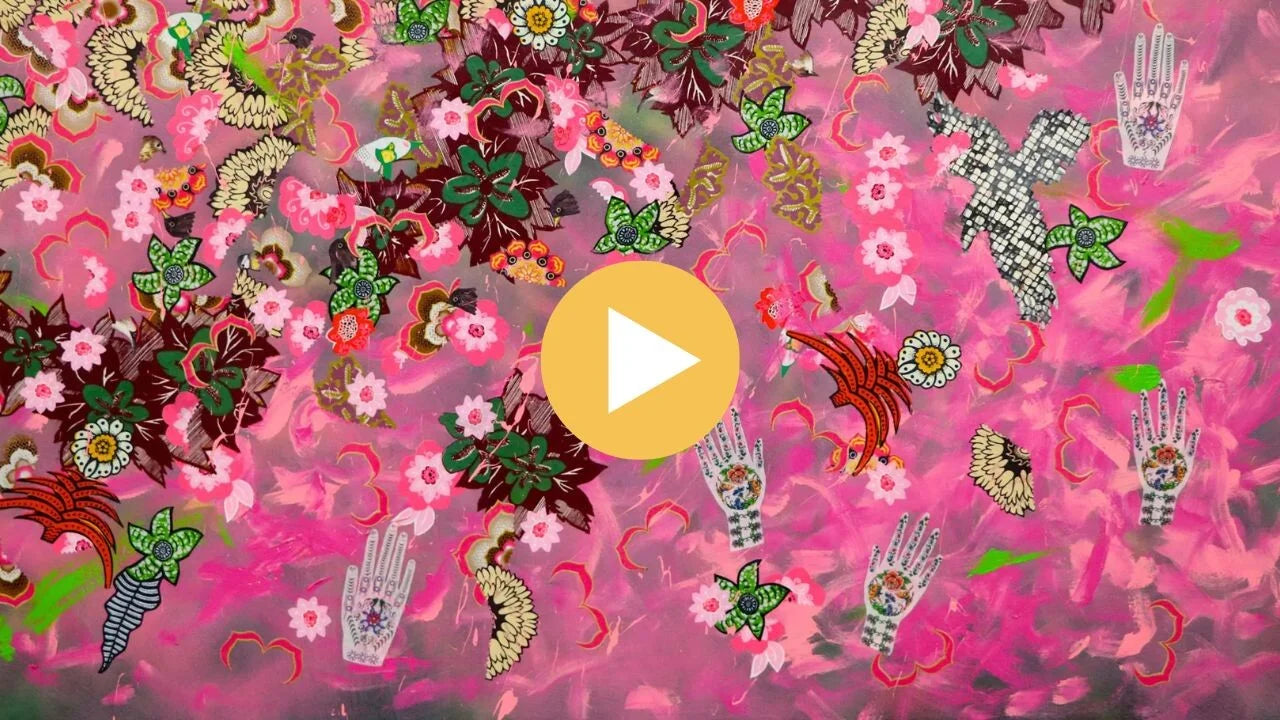 Merion Estes.Pink Power, 2018. Fabric coupled with mixed paint applications and photo transfers.
Merion Estes.Pink Power, 2018. Fabric coupled with mixed paint applications and photo transfers.
...
If coral reefs could scream in color, they’d sound like Merion Estes. Her paintings aren’t simply maximalist—they’re ecological sirens draped in rhinestone and velvet, shrieking joy and mourning in the same breath. Each canvas a biosphere, blistered and blooming, where pattern devours realism and beauty becomes too intricate to trust.
Estes doesn’t decorate. She warns. With fabric, paint, photo transfer, and the visual vocabulary of spectacle, she makes art that dazzles until you realize you’re drowning in it. Her works are the visual equivalent of a hurricane rendered in sequins.
Based in Los Angeles, Estes is a painter known for her profound commitment to a maximalist approach, crafting artworks that are as conceptually sharp as they are sensorially overwhelming. Her practice stitches together landscape, textile, kitsch, protest, and sacred disorder.
Artistic Style and Themes
Estes’ compositions seduce at first glance—lush textures, neon hues, kaleidoscopic arrangements. But they betray the viewer’s gaze. These aren’t safe spaces. Her nature is neither tranquil nor innocent.
Within her visual tempests are signs: melting ice, endangered flora, polluted tides. Her varied depictions of natural "scenes", from pastoral illusions to submerged fantasy realms, operate as coded ecological indictments. The beauty is bait. The politics are buried beneath silk-screened coral and spray-painted blossoms.
Her fascination with the fragile beauty of Earth gives way to a haunted optimism—one where nature’s abundance is both exalted and eulogized. Each canvas seems to ask: what if beauty was our last remaining language of resistance?
Pattern and Decoration Movement
Estes’ maximalism is deeply intertwined with the Pattern and Decoration movement, but hers is no ornamental escapism. She reclaims pattern as prophecy—a vernacular of excess that speaks to systems breaking down.
Through eclectic citations of design elements, she blurs distinctions between high and low, flora and fauna, landscape and textile. Her work shatters the western dichotomy of aesthetics versus ethics. In Estes’ universe, the decorative is political. Ornament is alarm.
She works in the tradition of decorative dissent, taking influence from Mexican kitsch, Persian miniatures, feminist quilting, and Californian surf psychedelia—yet collaging them into something too unruly to trace.
Her pieces often look stitched from nightmares and scrapbooks—rituals of survival camouflaged in pom-poms and plastic foliage.
Contemporary Relevance
Estes continues to stand as one of maximalism’s most politically urgent voices. Her exhibitions consistently reframe her work as both visually dazzling and politically motivated, allowing viewers to see not only the richness of her aesthetic—but the bleakness of what it’s trying to preserve.
Her voice has resonated within feminist art groups, environmental collectives, and pattern revivalists, but Estes herself remains uncontainable. Her work threads between genres and movements without asking permission.
She has said her paintings reflect the "historical forces of the sublime and the picturesque." In her hands, the sublime is no longer awe—it’s anxiety. The picturesque no longer peaceful—it’s performative. Estes weaponizes the beautiful, using it to seduce, then indict.
She doesn’t ask us to save the planet. She shows us how it already looks in its death throes—gorgeous, monstrous, and made from the same glitter we use to distract ourselves.
13
Jeff Koons
Watch: In Practice with Jeff Koons via GARAGE Magazine
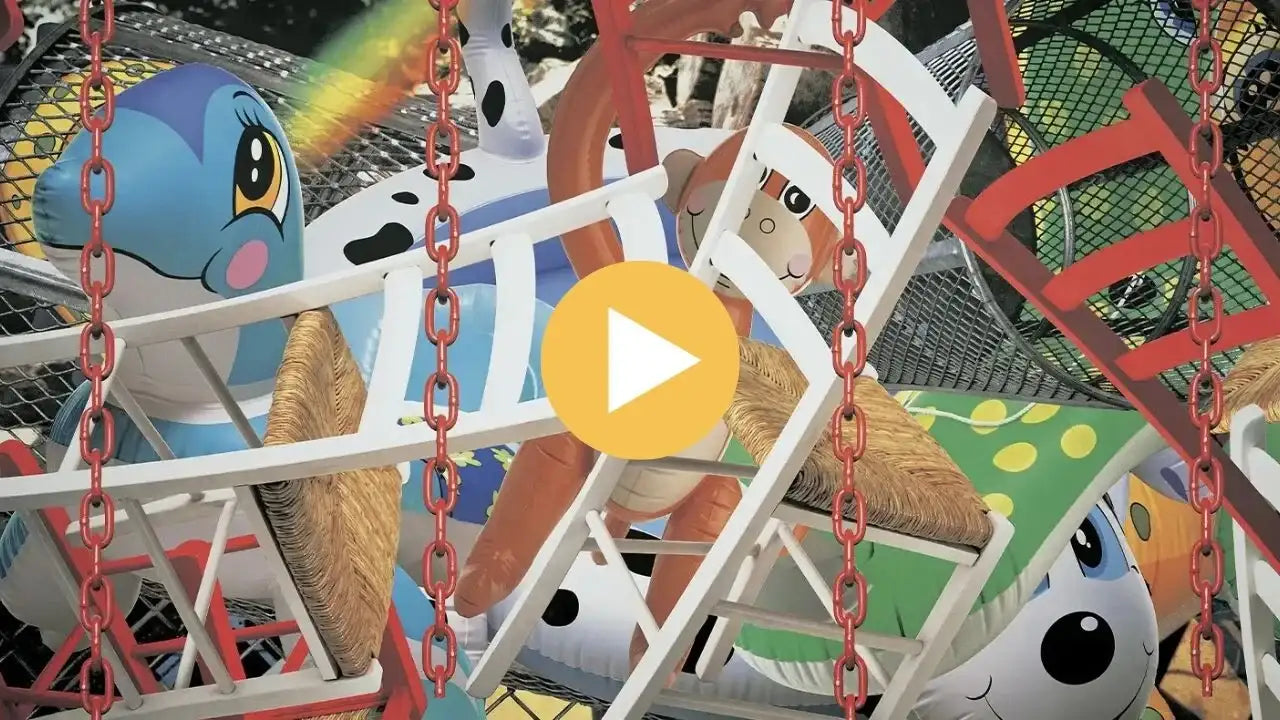 Jeff Koons. Backyard, 2002. Inkjet on canvas.
Jeff Koons. Backyard, 2002. Inkjet on canvas.
...
In Jeff Koons’ universe, excess is not an accident—it’s a doctrine. His art arrives in mirror-finish armor, reflecting not only the viewer but the marketplace, the tabloid, the tantrum of modern desire. Jeff Koons is one of the most prominent and polarizing artists of the contemporary era, and perhaps the only maximalist to make kitsch feel like scripture.
Nothing about Koons is small. Scale is his native tongue. A balloon dog the size of a chapel. A gazing ball that doubles as both relic and rear-view mirror. His maximalism is industrialized spectacle, forged in chrome and cunning, a factory-line of seduction.
Maximalist Approach
Koons’ work speaks through materials that don’t whisper—they glare: stainless steel, high-gloss pigments, vacuum-sealed perfection. He translates childhood into monument, sex into showroom, and pop culture into altar.
His infamous balloon animals, including the iconic Balloon Dog series, aren’t balloons at all—they’re cold-blooded simulacra. Hard as luxury goods. Impossibly polished. Designed not to breathe, but to endure. They turn nostalgia into architecture.
Koons has never pretended to be subtle. Where minimalism trims, he bloats. Where others critique capitalism, he embodies it—without irony, or perhaps with so much irony it circles back into sincerity. His maximalism is self-aware indulgence, poised at the edge of sincerity and spectacle.
Collaborations and Exhibitions
Koons has turned the art world into a revolving showroom. His works have been launched like rockets across the globe—the Louvre, the Whitney, the Gagosian empire—but also into boutiques, fashion houses, and collector homes gleaming in Architectural Digest spreads.
His collaboration with Louis Vuitton made headlines, merging high fashion with high-gloss conceptual art. The Masters series placed his signature reflective spheres atop reproductions of Titian, Rubens, and da Vinci. It wasn’t homage—it was occupation. The classical met the commercial, and they didn’t flinch.
The exhibition Apollo marked a pivot: new sculptures, readymade objects, and Koons untethered from the kitschier violence of his Banality series. But the maximalism remains. Koons doesn’t evolve—he scales.
Art in Homes and Interiors
You don’t merely buy a Koons—you interior-decorate your life around one. A single Koons piece reshapes a room into a temple of spectacle. His sculptures don’t just reflect—they dominate, like chrome-dipped totems of postmodern idolatry.
Homes with Koons pieces aren’t spaces; they’re theaters, curated down to the last surface. His work is frequently spotlighted in elite design media not just as art, but as status iconography—a maximalist code of taste and excess for the 1%.
Business Muscles and Pop Culture Impact
Koons is less artist than empire. His studio runs with the precision of a luxury brand. Technicians execute. Assistants polish. Concepts are briefed, not painted. He has mounted simultaneous global shows for years, moving art like product.
He understands audience not as a demographic, but as a market condition. His interviews read like business case studies. His sculpture sales break records and break discourse. He is maximalism in its corporate form—outsized, obsessive, and engineered for relevance.
Criticism and Interpretations
For every admirer, there’s a skeptic. Critics dismiss his work as kitsch, call him a salesman of simulation. They argue that Koons doesn’t critique capitalism—he manufactures it in art form. But perhaps that’s the point. Koons turns aesthetics into a mirror held up to appetite, and never pretends otherwise.
His art lives at the uncomfortable edge where satire and sincerity blur. He shows us a world so obsessed with polish, scale, and surface that even a balloon can become an object of worship—if only it shines hard enough.
14
Leigh Bowery
Watch: Leigh Bowery at The Clothes Show via BBC (1986)
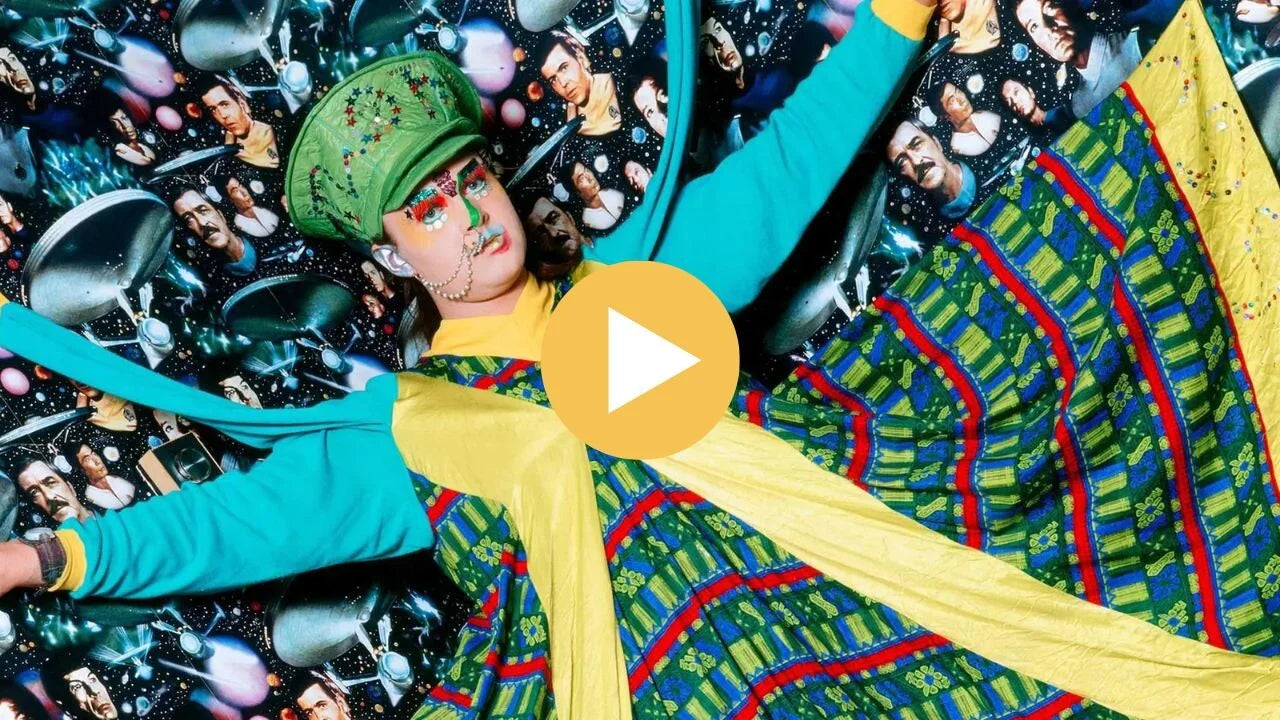 Robyn Beeche. Portrait of Leigh Bowery, 1984. Type C photograph on paper.
Robyn Beeche. Portrait of Leigh Bowery, 1984. Type C photograph on paper.
...
Leigh Bowery did not perform art—he blew it up. Night after night, his body was a live grenade of fabric, plastic, paint, and provocation. An influential Australian performance artist, club promoter, and fashion designer, Bowery turned London’s 1980s club scene into his runway and his altar, where he staged not a career, but a myth in motion.
If maximalism ever needed a prophet, it found one in Bowery: a flesh-and-sequin theology of audacity. Every outfit a refusal. Every strut a gender heresy. His body was not a canvas—it was a collision site, where glam met grotesque, and couture collapsed into chaos.
Intergalactic Maximalism
Bowery’s maximalism existed far beyond the realm of material. His art was lived, sweat-soaked, screamed into nightclub fog. He layered costumes like geological epochs—vinyl, feathers, pearls, bondage straps, inflatables, surgical tape. Nothing was subtle. Nothing was sacred.
Maximalism, a reaction against minimalism, found in Bowery its most committed evangelist. His garments were not clothes—they were moving sculptures, engineered not for elegance but for confrontation. And yet, beneath the confrontation, a strange, pulsing joy: the freedom of building yourself from everything you’ve ever been told to hide.
This was a rich mix of materials and styles, but also of selfhoods. Bowery’s maximalism was autobiographical polyphony. He didn’t just blur gender—he obliterated it. What emerged wasn’t androgyny. It was multiplicity.
Camp as Fk**
Bowery’s influence would mutate into theory. Scholars of “queer maximalism” often circle his legacy, not just for the visuals, but for the aesthetic of unmitigated flamboyance he embodied.
This wasn’t camp-as-wink. It was camp-as-weapon. His drag wasn’t about female illusion—it was about making illusion the only truth. He devoured beauty standards, swallowed gender binaries, and spit out sequined monsters.
Academic texts have cited him as a “venerated figure of representation and transgression,” but theory cannot contain Bowery. His work was designed to escape every box built to explain it.
He made stages out of sidewalks. He turned runways into riots. Bowery’s maximalism wasn’t just about visual spectacle—it was about declaring war on propriety.
Influence on fashion and Art
The echoes of Bowery’s delirious aesthetic still ricochet through high fashion and art galleries. Designers, artists, and performers often cite Bowery’s work as a source of inspiration, but most can only imitate his surface.
Few grasp the brutality of the vision underneath. The latex wasn't just shiny—it suffocated. The heels weren’t accessories—they were weapons. His performances at Taboo and other iconic venues weren’t acts—they were exorcisms.
He remains a maximalist ghost haunting fashion week, a fever dream flickering behind the eyes of anyone who’s ever tried to dress like a scream.
His legacy lives not only in garments or photographs but in every moment of visual transgression that dares to confront the gaze rather than seduce it.
Bowery built his body into a myth, and then shattered it. And like all myths, his power was not in being understood, but in being witnessed.
15
Sanford Biggers
Watch: Sanford Biggers via PBS NewsHour
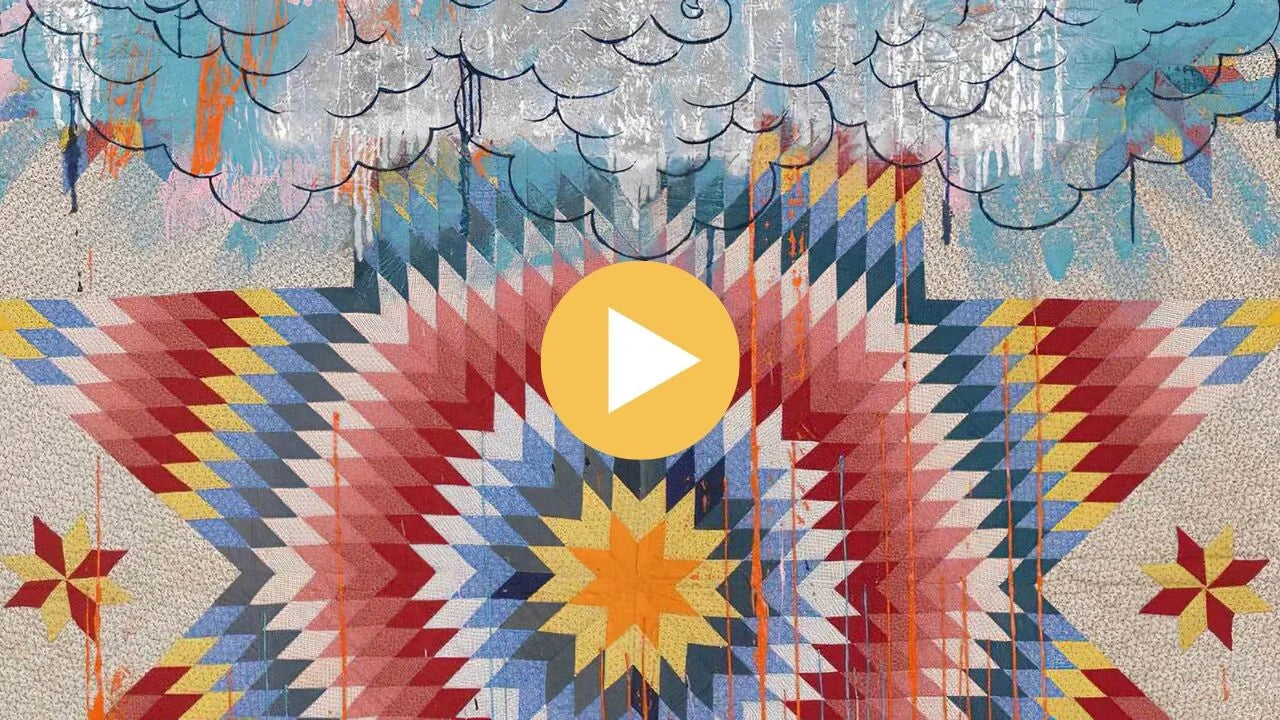 Stanford Biggers. Quilt No19 Rockstar. Repurposed quilt, fabric treated acrylic, spray paint and silkscreen.
Stanford Biggers. Quilt No19 Rockstar. Repurposed quilt, fabric treated acrylic, spray paint and silkscreen.
...
Sanford Biggers doesn’t make art—he rethreads time. His pieces are less objects than collisions: between ancestral trauma and Afrofuturist myth, Buddhist ritual and Baptist rhythm, formal sculpture and the defiant softness of salvaged cloth. Born in Los Angeles in 1970 and now based in New York, Biggers works like a time-traveling griot whose studio hums with ghosts and drumbeats, always stitching toward something that hasn’t yet been named.
Biggers' Maximalist Work
His entry into maximalism isn’t through surface—it’s through saturation. Each piece becomes a field of layered histories, entangled media, and thick symbolic density. Where minimalism asks what can be removed, Biggers asks: What must be recovered?
“A collaborator with the past,” he works with antique quilts, not just as textile but as encrypted documents—some rumored to be maps for the Underground Railroad, others encoded with survival itself. Onto these he paints, silkscreens, burns, and builds. A surface that once held a body now carries a story.
His maximalism isn’t about more for the sake of more. It’s resistance through accumulation. Materials become memory. Color becomes code.
Interplay of distinct histories, cultural narratives, and traditions
Biggers unspools the very notion of historical linearity. His installations are loaded with references: Yoruba cosmology, Buddhist mandalas, classical statuary, jazz. He sculpts Greco-Roman busts and fuses them with African masks, folding together centuries of gaze and countergaze.
His paintings on collaged antique textiles aren’t mere homage—they’re argument. His art tells us that history isn’t behind us. It’s stitched into the seams.
Sand mandalas made of dust and glass become not only offerings but elegies. A floor becomes a sanctuary of sand-quilting. In this ritual gesture, the ephemeral becomes monument.
Biggers’ practice evokes sampling in hip hop: citation without erasure. Quilts become turntables. Acrylic becomes beat drop. Threads loop into loops.
History and Dialogue
His work creates passageways—not just across media, but across time. American history, in his hands, isn’t one thing. It’s a ciphered mosaic. A code-switching incantation. A polyphonic visual language where slavery, spirituality, empire, and healing speak in chorus.
He confronts not only culture, history, art and racism but the very contexts that sustain them. Whether building monumental sculptures like Oracle in Harlem or subtler works in reclaimed domestic materials, Biggers renders visible the scaffolds that whitewash complexity.
This is maximalism as method and ethic. Nothing is singular. Nothing is static. Meaning isn’t found—it’s constructed, broken, and then reconstructed beneath your gaze.
Through his multimedia investigations—video, drawing, installation, sound, and performance—Biggers confronts the architecture of forgetting. He refuses to let the violence of erasure go unremarked.
Each quilt becomes a cartographic act. Each sculpture a rupture in Western art history. Each show a meditation on re-memory, as Toni Morrison might call it—history not remembered, but re-lived through visceral material engagement.
Biggers doesn’t ask you to understand. He demands that you feel: the friction of fabric, the weight of silence, the noise of inheritance. In a world that still tries to reduce complexity into slogan or spectacle, his maximalism insists on depth, nuance, and refusal.
16
Franklin Williams
Watch: EYE FRUIT: The Art of Franklin Williams via MSC
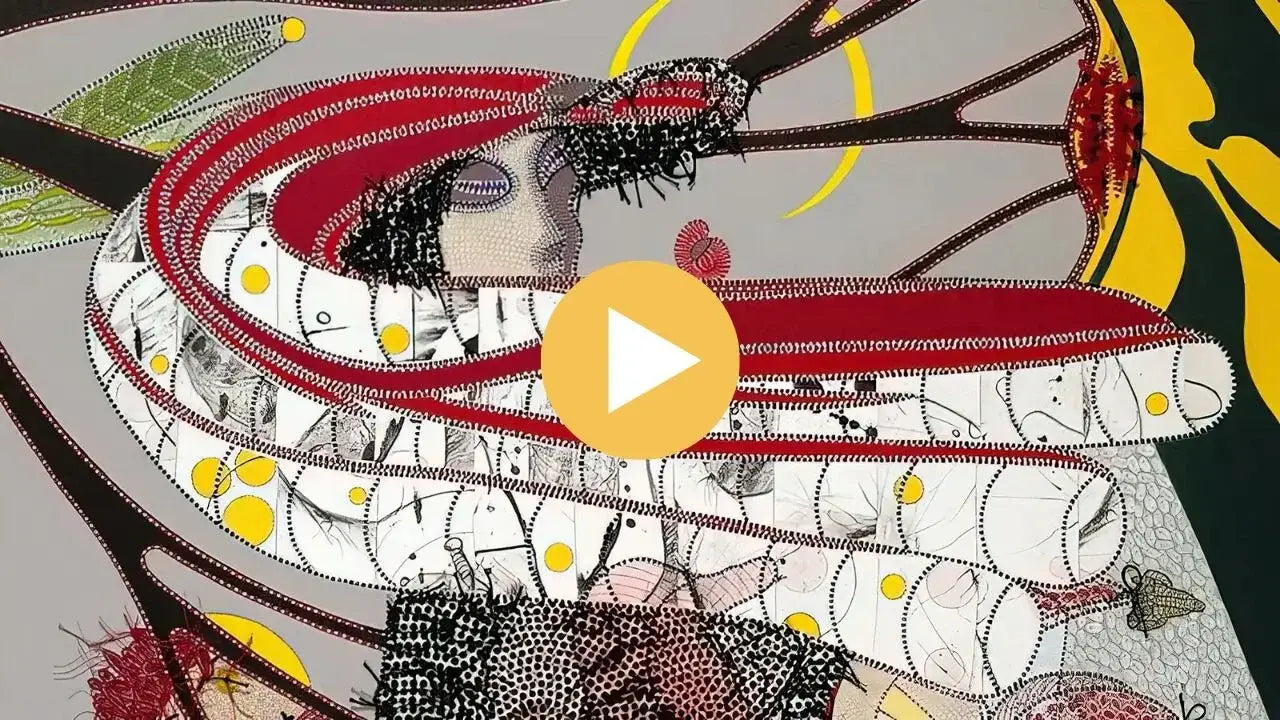 Franklin Williams.Raggedy Ann in Wonder Dream is Seen, 2020. Acrylic on canvas, cotton crochet thread, yarn and collage.
Franklin Williams.Raggedy Ann in Wonder Dream is Seen, 2020. Acrylic on canvas, cotton crochet thread, yarn and collage.
...
Franklin Williams is the cartographer of an inner galaxy spun from thread, pattern, and acrylic hallucination. Associated with the Bay Area, Williams occupies the liminal zone between outsider mystic and precision maximalist—his canvases neither painting nor sculpture, but living diagrams of imagination laid bare.
Born in the 1940s and shaped by the Funk Art movement, Williams emerged with the countercultural tide of the 1960s and 70s—but unlike the movement’s brash vulgarity, his maximalism pulses inward. His world is stitched, not screamed. Muted only at a glance. Upon closer study, it crackles with coded symmetries and surreal compulsions.
Funk Art Movement
Franklin Williams’ trajectory through the Funk Art movement was tangential but undeniable. While his contemporaries in the Bay Area reveled in grotesque figuration and anti-aesthetic swagger, Williams burrowed instead into meticulous detail, constructing dreamscapes out of hand-stitched materials and obsessive layering.
His breakout piece, Yellow Apron (1970), composed of acrylic, fabric, yarn, and nails on canvas, doesn’t hang so much as vibrate. It’s a shrine built from housework, imagination, and discomfort—a kind of domestic surrealism as resistant form.
He approaches maximalism through accumulation not of noise, but of texture, form, and psychological density.
Visually Engaging and Unique Aesthetic
To view a Williams canvas is to be pulled into a centrifuge of geometric patterns, amoeba-like organisms, color-blocked portals, and delicate chaos. There’s no single entry point—each visual element interrupts the last, builds toward nothing linear, resists narrative, and yet somehow tells a story.
His use of bold colors, nested shapes, and hand-applied textile components creates a surface that bristles with intention. It’s like looking into the mind of someone dreaming in code and trying to communicate without language—just loops, knots, and pulses of color.
These are not safe, coherent abstractions. They are psychic excavations, ruminations rendered physical. The longer you look, the less you see objects and more you sense moods. The work behaves like memory—fractured, recursive, unresolved.
One Movement After Another
Williams has eluded categorization for decades. Critics and historians have tried to pin him to “at least five movements”, but his art refuses that taxonomy.
He traverses conceptual abstraction, textile craft, queer sensibility, and psychedelic aesthetics, offering up self-portraits, symbolic topographies, and strange biological grids that feel like anatomical studies of emotional terrain.
His works whisper through decorative maximalism, yet they hum with quiet mania. There's something lonely and loving in his process, a sense of building cathedrals out of thread just to climb inside them and rest.
You don’t just look at Williams’ art—you enter it, disoriented. It’s a ritual of excess as intimacy, a maximalist embrace of everything too quiet, too slow, too complex to survive in the usual noise of contemporary art.
Through decorative blends of ageless curiosity and ennui, Williams makes maximalism personal again—not as protest, not as performance, but as survival. His art says: here is what I made when the world refused to explain itself.
17
Liza Lou
Watch: Liza Lou's Kitchen via Whitney Museum of American Art
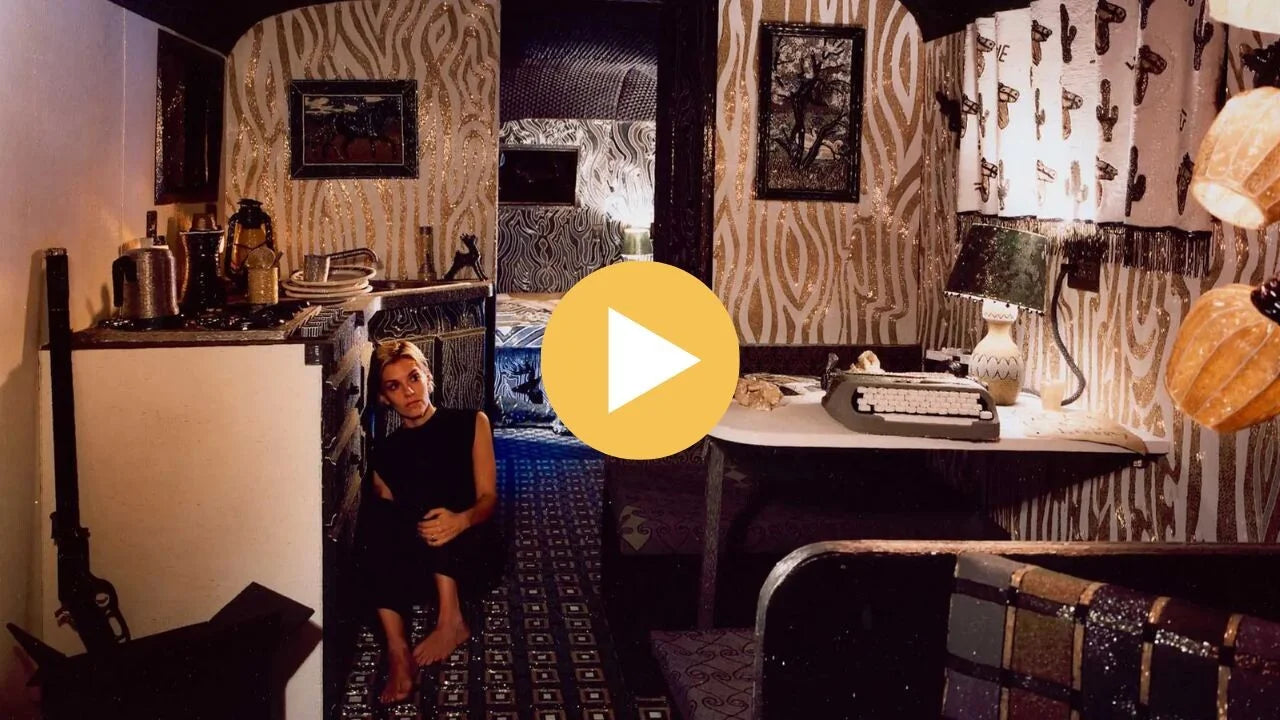 Liza Lou. Testimony, 2002. Glass beaded trailer.
Liza Lou. Testimony, 2002. Glass beaded trailer.
...
Liza Lou does not simply create objects—she conjures endurance into form. Every inch of her monumental sculptures is dense with time: time bent, broken, rebuilt bead by bead. A prominent American visual artist, Lou transforms the meticulous act of labor into a sacred gesture—equal parts rebellion, ritual, and maximalist hymn.
Where others chase spectacle, Lou weaves glass beads over steel or aluminum with an almost devotional precision. Her work is slow, deliberate, and resolute in its refusal to hurry. In a world addicted to speed, she dares to make you stare at hours turned solid.
Technique and Materials
Lou’s materials are deceptively ornamental—glass beads, often associated with the decorative or domestic, become here a weapon. Each bead stitched not for adornment, but as an assertion. Her maximalism is less visual overload than durational intensity: a saturation of touch, repetition, and manual insistence.
The act of beading, often dismissed as “craft” or “women’s work,” becomes for Lou a radical act of precision and scale. Her technique both honors and transcends tradition, invoking histories of marginalized labor while breaking open space for contemporary confrontation.
Cultural and Social Commentary
Lou’s maximalism confronts more than aesthetics—it addresses confined labor, gendered expectation, and emotional architecture. In her famed piece Maximum Security, she constructs environments not just of glitter, but of claustrophobia. Beauty becomes surveillance. Ornament becomes constraint.
Each sculpture is a kind of unspoken monologue about what it means to occupy a role, to repeat a motion until it transforms into both meditation and burden.
The beadwork speaks in two voices: one tender, one furious.
Notable Works
Her seminal work Kitchen—a life-sized, fully beaded domestic kitchen—required five years of obsessive attention. Here, maximalism doesn’t mean extravagance—it means the accumulation of invisible labor made visible.
This kitchen is not a celebration of home. It’s a shrine to the monotony of expectation. Every glistening surface dares the viewer to ask: Who gets to call this art, and who had to endure it?
In Backyard, her continuation of this domestic narrative, she encrusts leisure space with the same painstaking detail. There are no shortcuts. Every blade of grass is counted. Every moment of invisibility is counted back into being.
Her maximalist approach is devotion weaponized.
Lou’s labor doesn’t romanticize—it documents. The evidence is in every bead, like sweat crystallized into permanence. This is what time looks like when it refuses to disappear.
18
Stephanie Syjuco
Watch: Stephanie Syjuco in "San Francisco Bay Area" via Art21
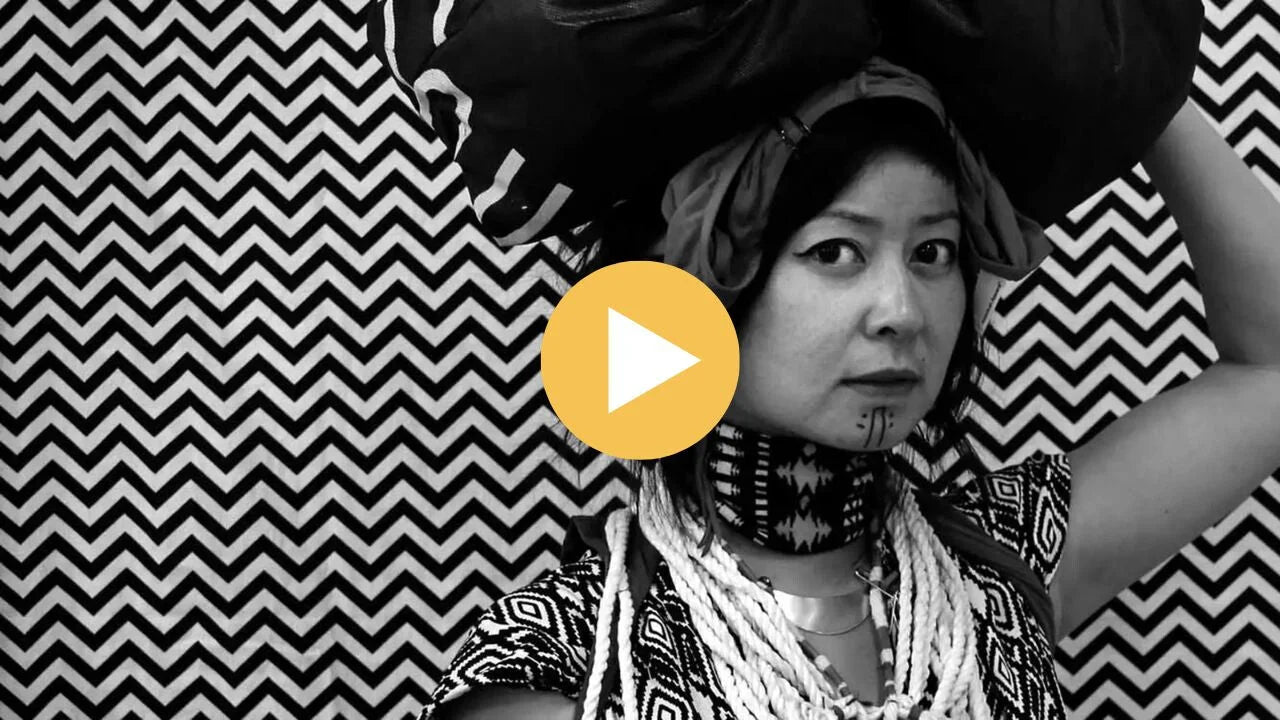 Stephanie Syjuco. Cargo Cults: Head Bundle,2013-16. Pigmented inkjet print.
Stephanie Syjuco. Cargo Cults: Head Bundle,2013-16. Pigmented inkjet print.
...
Stephanie Syjuco cloaks her critiques in glittering skin. Her maximalism is camouflage—strategic, seductive, and sharp enough to slice. Born in Manila in 1974, now working in the Bay Area, Syjuco doesn’t just make art—she sets traps. Pattern becomes bait. Color becomes confrontation. Her work engages with maximalism, not to delight, but to overwhelm and reveal.
If Leigh Bowery built spectacle into the body, Syjuco threads it through identity itself—fabricating selves from the cheap seams of global commerce. Her art asks: What happens when authenticity becomes a product line?
Cargo Cults Portrait
The Cargo Cults series skewers this question. Syjuco stages photographic portraits in which the sitters—herself included—are wrapped in mass-manufactured goods purchased from American shopping malls, styled into “ethnic” costumes. At first glance, the effect is lush. Printed textiles bloom like tropical markets. But look again: the patterns are knockoffs. The fabrics synthetic. The backdrops loud enough to erase the subject.
This is maximalism as trapdoor, as critique of the mass-market production of 'ethnic' patterns, and the fantasies they feed. Syjuco knows exactly what you’re drawn to—and weaponizes it.
Confronting Identity through Maximalism
In Syjuco’s world, visual pleasure is suspicious. Identity is rendered unstable, pixelated, performative. Her subjects nearly vanish into their ornamental surrounds—challenging viewers to distinguish between subject and background, self and stereotype.
Her maximalism is not about abundance—it’s about displacement.
She weaponizes density. Embellishment becomes distortion. Representation collapses into ethnographic noise. Through this flood of signs, she critiques the very systems that taught us to read “cultural authenticity” as a consumable aesthetic.
Critique of Western Decorative Impulse
Syjuco’s installations and images pick apart the Western hunger for Otherness. Her pieces do not mimic imperial archives—they confront them. Her "maximalist decorative impulse" becomes a scalpel, carving through the illusion that beauty is neutral.
In work after work, she dissects the idea that ornament can ever be innocent. Patterns repeat—but the repetition is never benign. Beneath the saturated colors is a reckoning. The surface always whispers: Who is being looked at? And who gets to look?
Maximalism, in Syjuco’s hands, becomes a mode of resistance and repair. A way to flood the Western gaze until it cannot see. A visual cacophony loud enough to drown out the voice of empire.
19
Pae White
Watch: Pae White via NGV Melbourne Triennial
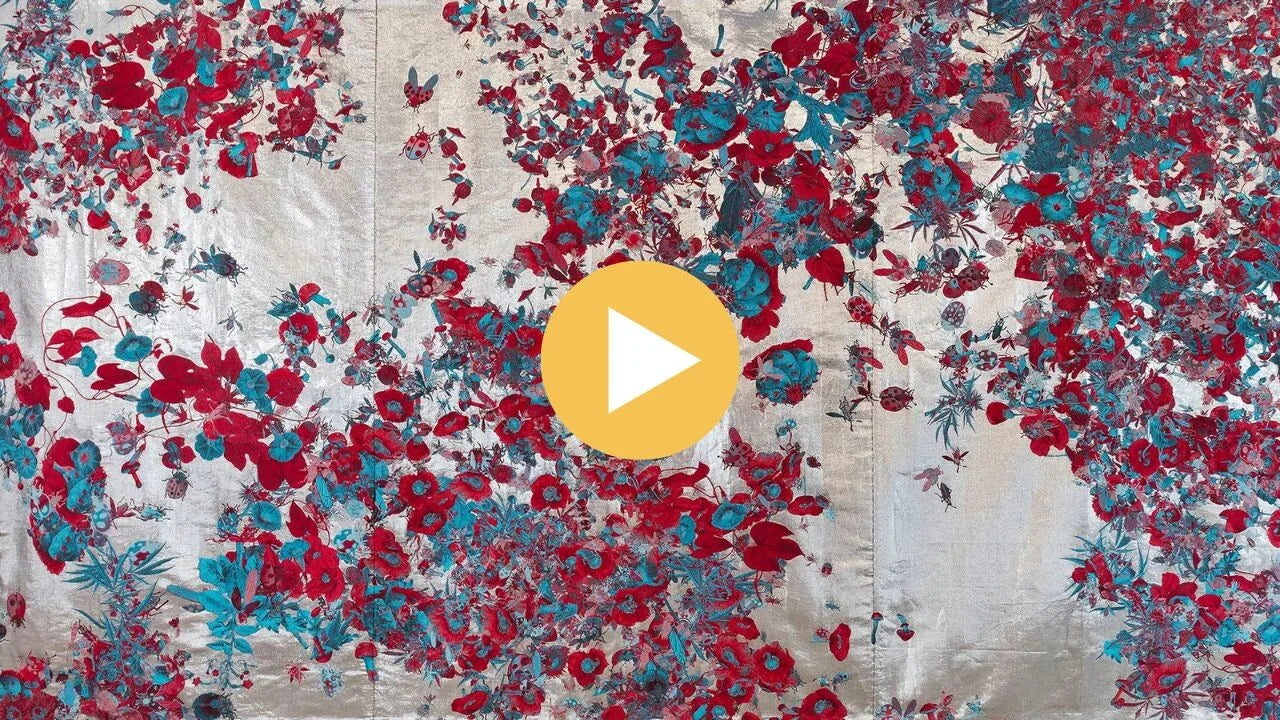 Pae White. Bugz & Drugs, 2017.159.8 x 316.1 inches.
Pae White. Bugz & Drugs, 2017.159.8 x 316.1 inches.
...
Pae White does not sculpt objects—she warps attention. Her maximalism is not a scream of color or an orgy of detail. It is a slow hallucination, a trapdoor opening beneath your assumptions of space and substance. Based in Los Angeles, White reconfigures the ephemeral qualities of everyday life—dust motes, candy wrappers, vapor trails—into vast, immersive installations that collapse the boundary between the domestic and the divine.
Her work is maximalism as phantasmagoria: a conjuring of ghosts through thread, foil, porcelain, sound.
Materiality and context
White’s genius lies not in what she uses but in how she estranges it. Her multifaceted body of work—tapestries, video, sculpture, site-specific interventions—uses humble materials (paper, tinfoil, yarn) to reconstruct the forgotten textures of daily existence. But in her hands, the ordinary doesn’t stay that way. It becomes operatic.
Educated at Art Center College of Design in Pasadena, she emerged from a milieu saturated with formal rigor. But White rejects minimalism’s austerity in favor of sensory excess—not for spectacle’s sake, but to collapse perception into poetry.
Her works aren’t just to be viewed. They are to be breathed. Walked through. Disoriented within.
Abundance and excess
In Bugz & Drugs, she enlarges the microscopic and the discarded—those things that flit at the edge of your awareness—into monumental, theatrical compositions. But the real spectacle is what the work does to your sense of scale, time, and material logic. What once fluttered by unnoticed now looms like cathedral fresco.
She doesn’t clutter. She envelops. Her maximalism is not a matter of adding more—it’s the ability to make a single wisp of smoke feel as present as a mountain.
The surfaces shimmer, but not to dazzle—they shimmer to dislocate. The viewer is no longer in a gallery but inside an argument between matter and light.
This is not a fetishization of domesticity. It is a warping of its edges—fabrics pulled loose from function, domestic references set adrift in scale and material. She lifts curtains from windows and hangs them like auroras. She plucks threads from childhood memory and reweaves them into floating cathedrals.
Her art speaks in murmurs, but it multiplies.
If Koons is maximalism’s showman and Syjuco its insurgent, then White is its conjurer. She makes the unseen tangible—not by solidifying it, but by making its absence echo.
20
Haegue Yang
Watch: Haegue Yang: Strange Attractors via Tate
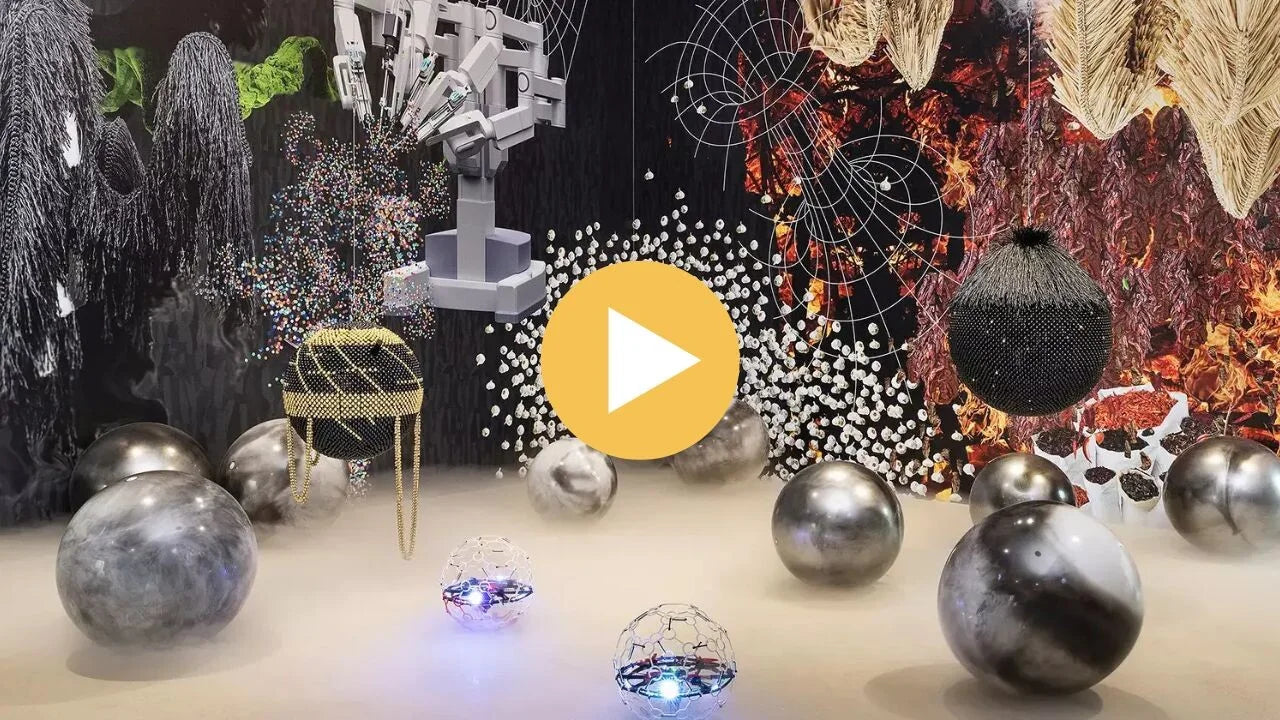
...
Haegue Yang doesn’t assemble objects—she arranges atmospheres. Her maximalism is not a riot of visual density, but a geometry of sensation, where synthetic materials hum with ritual intent and contradiction becomes a compositional principle. A renowned South Korean artist, based in Berlin, Yang conducts her exhibitions like scores—silent yet kinetic, industrial yet tender, rational yet erupting with affect.
If Pae White distills the ephemeral, Yang electrifies the immaterial. Her works don’t just occupy space—they reconfigure how space feels.
Large-scale Installations and Intricate Sculptures
Her sculptures sprawl into rooms like maximalist mixes of artificial tropical plants, maypole-like pillars, and ambient soundscapes. But they aren’t installations in the decorative sense—they’re stage sets for phenomenological inquiry. They incorporate a wide array of materials, from Venetian blinds to scent-diffusers, steel frames to bells, all calibrated to disorient, seduce, and stimulate.
These pieces are choreography disguised as sculpture. The eye doesn’t know where to land; the body doesn’t know how to orient. And that is precisely the point.
Her maximalism isn’t accumulation—it’s relational tension made visible.
Reconfiguring / Deconstructing
Take Sol LeWitt Upside Down—Yang’s commissioned installation that inverts LeWitt’s minimalist cubes, constructing a suspended, spinning architecture out of venetian blinds. The result is both austere and dizzying, a gravity-defying pyramid that mocks minimalism’s grid with theatrical movement.
She turns LeWitt’s logic inside out, suffusing it with play, warmth, and destabilization. This isn’t homage—it’s détournement.
Yang’s practice thrives on these collisions: East and West, sacred and industrial, sculptural and sonic. Her works reshape ordinary materials into complex artistic expressions, and in doing so, they reshape the viewer’s internal calibration.
Contribution to Maximalist Art
Yang’s contribution to maximalism lies in her refusal to simplify complexity. In her hands, maximalism becomes a strategy of immersive contradiction: a way to hold multiplicity without flattening it.
Her pieces often reference the histories of diaspora and displacement—not through figuration, but through texture, movement, and mood. She builds affective weather systems. The viewer enters not a room but a ritual.
If maximalism once meant ornament, Yang redefines it as conceptual saturation—an aesthetic of dense emotional geometry. Her installations don’t scream; they vibrate.
She has built a career by resisting legibility. Yet through her refusal, she has created one of the most distinctive maximalist vocabularies of the 21st century: synthetic, slippery, sentient.
—
For Lazy Nerds and Visual Learners
Maximalist Artists on YouTube
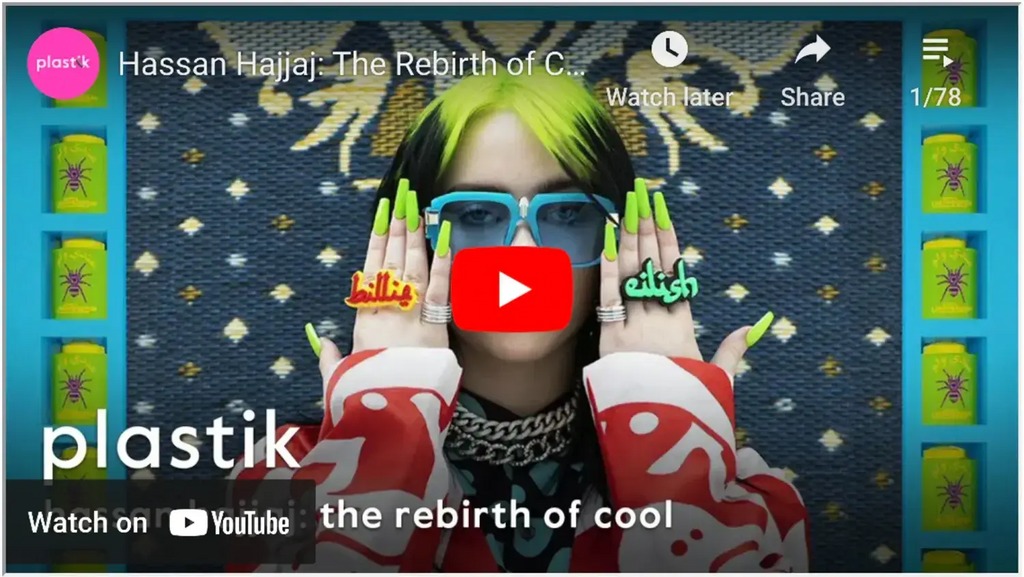
Understanding Maximalism
Maximalism does not whisper. It sings in chiaroscuro crescendo, a symphonic rebellion draped in velvet and contradiction. It is not simply the opposite of minimalism—it is its unruly dream-double, its ornate dissenter. While minimalism seeks a purified void, maximalism luxuriates in fullness. This is not design for the faint of heart. It is aesthetic maximal oxygen saturation.
Definition of Maximalism
To define maximalism is to trace a baroque spiral rather than a clean line. It is an artistic response to minimalism, but also a gleeful refusal to edit desire. A maximalist space is less curated gallery, more cabinet of curiosity that’s exploded outward. Vibrant colors, intricate patterns, and stylistic fusion run riot. The phrase "more is more" is not motto but manifesto—decorative insurgency by way of deliberate excess.
Yet even maximalism has its curated versions: minimalist maximalism, the stylist’s holy grail, found scattered across the high-gloss pages of Architectural Digest. It’s restraint dressed in drama. Editorial opulence delivered with mathematical precision. And still, whether riotous or refined, maximalism’s core is this: a commitment to personal aesthetic truth, unencumbered by symmetry, cohesion, or apology.
Characteristics of Maximalist Art
A maximalist painting is not a surface—it’s a plunge. A full-bodied dive into detail, contrast, and density. This genre doesn't merely depict—it overwhelms, delights, and disorients. At its heart:
-
Embraces excess: The maximalist canvas groans with detail. Nothing is trimmed, nothing withheld.
-
Uses vibrant colors: Color isn’t accent—it’s orchestra. The hues shriek, hum, pulse.
-
Favors intricate details: Every inch speaks. Each layer births another.
-
Experimentation with scale: Proportion is play. Monumental or miniature—each form asserts its place.
-
Diverse mediums: Collage, installation, sound, fabric, code—maximalism crosses disciplines with abandon.
-
Celebrates individuality: Every piece is autobiography in confetti-form.
-
Focuses on decoration and pattern: Not embellishment, but essence. Pattern is language. Ornament is ontology.
Maximalism refuses to edit the self for the sake of palatability.
History and Evolution of Maximalism in Art
The 1970s cracked the minimalist calm wide open. Maximalist artists erupted from the silence with defiant abundance. In a postmodern moment that prized fragmentation over purity, they painted, sculpted, staged the aesthetic equivalent of a carnival uprising. Complexity was not a failure of vision—it was the vision.
From the patchwork maximalism of Grandmillennial interiors, to the staged saturation of Instagram museums, and the leafy chaos of plant-filled Jungalows, the lineage is rich. Textures multiply. Color riots. Form splinters and recombines. Maximalism is not a single movement—it is a method of artistic respiration, evolving with each cultural exhale.
The Popularity of Maximalism in Contemporary Art
In an age allergic to boredom, maximalism is a visual sugar rush we can’t quit. Contemporary artists have embraced its codes not just as aesthetic, but as ethic. Pattern and decoration, once dismissed as feminine frippery, now bear conceptual weight. Color becomes counterculture.
The "Less Is A Bore: Maximalist Art and Design" exhibition did not just show art—it declared war on restraint. Beyond gallery walls, maximalism’s language is legible in eclectic interiors, immersive social media art spaces, and the curated chaos of lives lived online.
Maximalism speaks to this era’s deepest contradictions: the desire to express and the fatigue of optimization. It mirrors the plurality and complexity of our identities and challenges what beauty should do. This is art for the overstimulated, yes—but also for the seen-too-much and feel-too-deeply.
It critiques capitalism even as it uses its tools. It stages excess to resist disposability, crafting not objects, but worlds that linger.
Influence and Impact of Maximalist Artists
To understand the reach of maximalist influence, one need only walk through the Institute of Contemporary Art in Boston, where Ettore Sottsass’s radical patterns sit beside Liza Lou’s beaded devotions, Sanford Biggers’ layered symbolism, and Marcel Wanders’ opulent provocations.
These artists didn’t merely decorate. Their work was not subtraction but symphony, not minimal purity but maximalist plurality, drawing from folk traditions, decorative crafts, gendered ornament, and global influences.
Maximalist artists today fold their cultural heritages into every pattern, their politics into every flourish. Textiles become testaments. A beaded surface becomes a manifesto. Maximalism rewrites taste, dares to make beauty from what dominant culture called “too much.”
They don’t just fill a room. They redefine it.
The Future of Maximalism
As minimalism buckles under the weight of its own aesthetic fatigue, maximalism soars. It’s not trend—it’s terrain. It’s been declared “back” in 2023, but it never truly left. Joy, ornament, story, and texture are eternal languages.
What’s new is the boldness. Artists are no longer apologizing for saturation. They are amplifying it. We see maximalism morph into sensorial utopias—AR-enhanced murals, layered textiles with embedded sound, rooms that feel like stepping into dreams.
Maximalist décor is now political, psychological, ecological. It says: I exist. I remember. I reclaim. Maximalism is less about taste and more about testimony. In the future, it won't just decorate walls—it will speak through them.
How to Appreciate Maximalist Art
To stand before a maximalist artwork is to stand before a storm, a tapestry, a maze. Appreciation requires surrender, not judgment. It asks:
-
Abandon preconception: Let go of ideas about “taste” or “restraint.” Let it be loud.
-
Embrace overload: The detail is the message. Overwhelm is the point.
-
Engage your body: Texture matters. Sound, scent, presence—maximalism is somatic.
-
Seek narrative: Stories are buried in layers—ancestry, identity, rage, delight.
-
Marvel at labor: These works are not tossed off. They are devotional feats.
-
Allow contradiction: Discomfort is as valid as delight. Maximalism is about range.
-
Relate personally: The best maximalist art gives you back to yourself in brighter fragments.
-
Read diversity: Color, culture, pattern—all are voices. Listen.
-
Consider setting: Context reframes meaning. A maximalist piece in a white cube isn’t the same as one in a brownstone bedroom.
-
Trust your gaze: Your attention is the final collaborator. Stay with the work long enough to change it—and let it change you.
Incorporating Maximalist Decor into Your Space
Think of your space not as a room, but as a stage, and maximalism as the script where every object plays a role. Don’t seek cohesion. Seek dialogue.
-
Splash bold colors like declarations across walls.
-
Clash patterns with intentional chaos—let paisley talk to polka dots.
-
Drape velvet, silk, faux fur with unapologetic drama.
-
Let collections colonize your shelves—books, trinkets, talismans.
-
Build a gallery wall that refuses symmetry and demands time.
-
Invest in statement furniture that struts, not shrinks.
-
Play with lighting like mood music—glow, gleam, gasp.
-
Mix textures with abandon—shag, grain, gloss.
-
Use mirrors like portals.
-
Pile on accessories like the room is dressing for a gala.
-
Collage vintage and modern until history melts.
Maximalism is not mess. It’s composition by instinct, fantasy with a floor plan.
Exploration of Maximalist Wall Art
A maximalist wall is not a surface—it’s a fresco of excess. A breathing canvas. It beckons and swallows.
Artists like Jamison Gish, Seek One, Wegs.Art, and Burcu Korkmazyurek summon lush, chaotic, impossible-to-ignore universes that reach out and rearrange your senses.
Whether in the form of a mural that devours a hallway or a gallery-style explosion of small works, the goal is the same: make the wall feel alive.
Techniques shift from collage to textured acrylic, from vintage wallpaper prints to neon 3D sculptures. And all of them speak the same dialect: delirious beauty.
To hang maximalist art is not just to decorate. It’s to disrupt. It’s to demand attention in a world of passive scrolling. Oversized canvases? Absolutely. Clashing panels? Even better.
Conclusion
To walk through the lives of the 20 maximalist artists we’ve explored is to be drenched in color, caught in the swell of detail, intoxicated by the courage of aesthetic rebellion. From Iris Apfel’s wardrobe as mythos to Ulyana Sergeenko’s couture folktales, maximalism redefines what it means to be seen.
It offers a generous, unruly, utterly personal alternative to sanitized restraint.
And maybe that’s the point. Maximalism doesn’t ask for permission. It overwrites the white wall, it hums in too many colors, and it knows, more than anything, that abundance is not indulgence—it’s survival.

